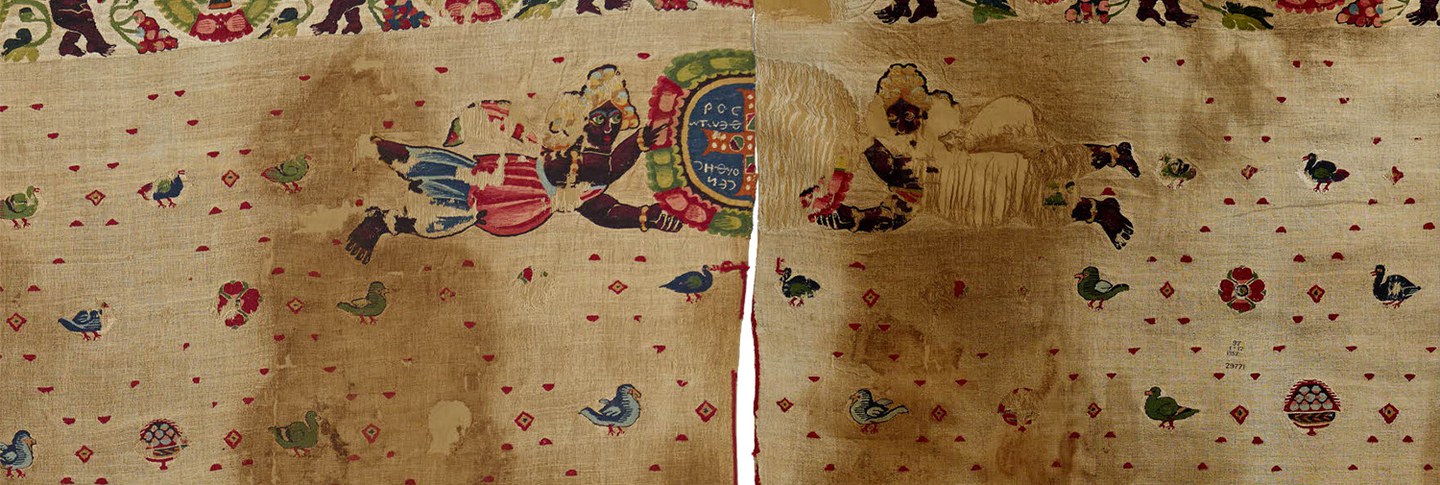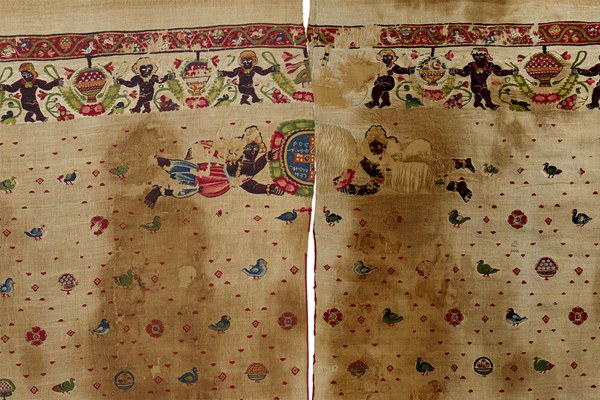To recognize that curtains were placed at thresholds is only to begin imagining them in their original architectural and experiential contexts. The task of this discussion, seeking to increase our understanding of surviving textile fragments, is to reconstruct, as far as possible, some of the environments in which early Byzantine curtains were used, and to see when, why, and how curtains might be hung, whether singly or in pairs. Because of their survival as a structural unit, a pair of curtains now at the British Museum (EA29771) provides a number of instructive insights and is the main subject of the first part of this study (figs. 1a–b). The second part further explores connections between the functions and mechanics of hanging curtains and the curtains’ design. Their functions were certainly physical and practical, but curtains could be at the same time dramatically strategic arbiters of ceremonial public or stately private space, communicating messages of social, aesthetic, or religious significance. The third part of the present study therefore presents some experiential aspects of curtains and their effects on spiritual imagery, using some evidence from depicted curtains and other works of art.
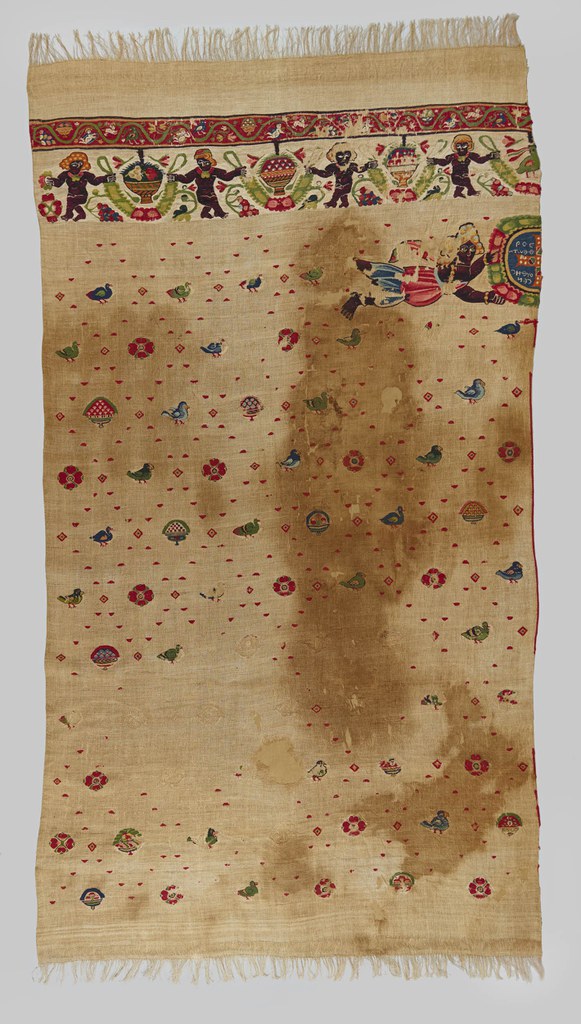
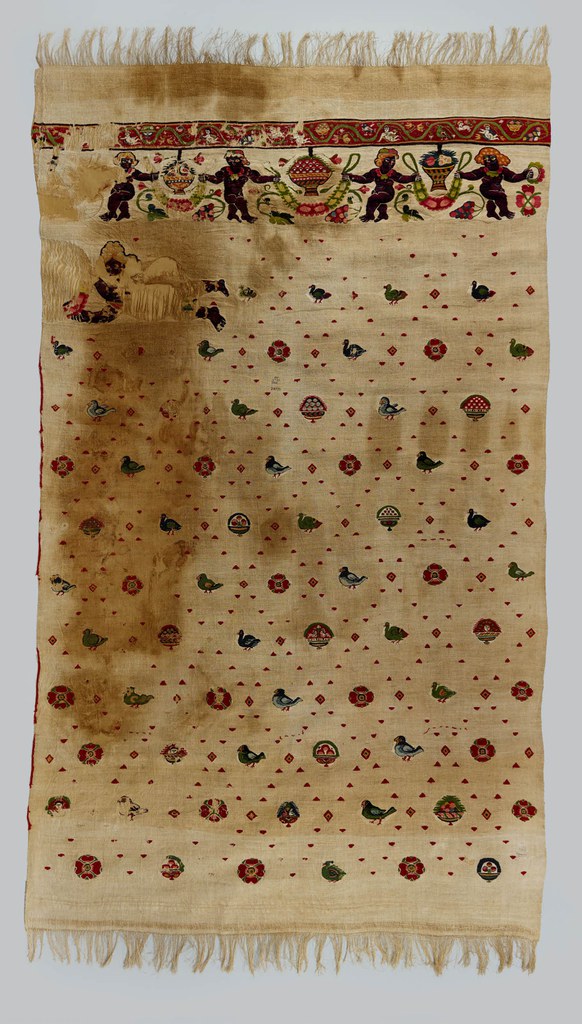
Propitious imagery suggesting birdsong and fragrance covers the British Museum curtains by the yard, as well as many other curtain fragments. A lattice-like grid of rosebuds or petals unites a lively scattering of birds and blossoms, and multiple presentations of fruit or flowers, without strict duplication. These motifs were familiar in Egypt, where the curtains were found, and where there was a strong Byzantine inheritance of Roman and Hellenistic repertories; their arrangement suggests important questions about the ways in which curtains were used throughout the empire. The curtains that hung in doorways of great Byzantine churches—like those of Hagia Sophia in Constantinople—may be lost forever; although we cannot say whether they were plain or figured, some things can be learned about them nonetheless.
Liminality being a spiritual as well as a physical concept, the woven door curtains that appeared in the late antique and Byzantine environment appear in descriptions of physical details of places as well as in expressions of spiritual experience and in commentaries on scripture. The liturgical use of curtains in the Byzantine church subtly dramatizes the idea of a curtain as a barrier. This type of liturgical stagecraft evolved from and reciprocated certain nonliturgical, even secular, uses of curtains at spatial boundaries: in the humblest and smallest houses a curtain could serve as a wall dividing a room, or as a means of separating indoor from outdoor space.J. W. Stephenson, “Veiling the Late Roman House,” Textile History 45, no. 1 (2014): 3–31. Both aspects of curtains, the practical or mechanical and the affective or meaningful, were experienced by people occupying or passing through spaces where curtains were to be seen, and can better be understood by examining material evidence in conjunction with depictions and texts that help us visualize the curtains in use. Their usefulness for mundane as well as more esoteric functions depended almost entirely on sensory experiences of perception. Curtains could be almost static place-markers, with pleated folds, held in place by the ties that restrained them against a wall, a column, or a jamb; or they could gently fill with air like tethered sails; they could merely suggest or effectively complete the division of an open space; they could hide or display areas or things or persons; and they could be pushed or pulled informally or ceremonially, and gathered up or dropped to give or deny access.

A door curtain’s presence and visibility was important enough to be represented on the model of the basilica that the sixth-century bishop Eufrasius of Poreč dedicates to the Virgin in his mosaic portrait in the apse of the actual building (fig. 2). The white curtain adorned with red is included as part of his gift, half drawn back but enlarged for emphasis so that the doorway in which it hangs takes up the entire façade, giving a powerful message of accessibility.A. Terry and H. Maguire, Dynamic Splendor: The Wall Mosaics in the Cathedral of Eufrasius at Poreč (University Park, PA, 2007), 111, fig. 33; A. Terry, “The Opus Sectile in the Cathedral at Poreč,” DOP 40 (1986): 147–64; G. Noga-Banai, Galit, “Time and Again in Poreč: A Note on the Decoration Program in Basilica Eufrasiana,” Ikon 1 (2008): 79–90. This curtain, in its exaggerated size replacing the wall and the door, offers more than the sign of an entryway for persons. It identifies the role of the bishop-builder with that of the priest Aaron, whose great white linen curtains veiled the Tabernacle he built to God’s instructions; for Aaron, and presumably for Eufrasius, entering past the curtain meant coming into God’s presence. By presenting a church with an open curtain, Eufrasius assumes the privilege of offering that opportunity to his flock of believers. At the same time, this drawn-open curtain identifies the whole west wall of the church with the admission of light. Light itself, with its spiritual meaning, would enter the actual church of Eufrasius, past the bright door curtain and through its fabric. At the opposite end from the entrance, the bishop in the apse mosaic stands above a series of opus sectile panels. There, between two inlaid images of candles in tall tripod stands, the wall above the bishop’s throne is curtained with a starry cosmic screen, not woven but expressed as a softly shining geometric grid or lattice pattern in mother-of-pearl. At its center, as light’s destination and source, a yellow cross gleams as a focus of light defined against the dark ground of eternity, above the rivers of earthly paradise. And if the door curtain of the model church displayed by Eufrasius is a partial barrier against the outside world, as the curtains in the actual doorway would have been, it is also an invitational locus of softness and openness in a hard, enclosed structure.
Surviving hardware at church portals indicates that curtains were suspended outside the valves of the door, not inside the doorway. Such curtains were therefore very much part of the exterior aspect of the church entrance. No surviving pair of Byzantine curtains has been definitively identified as having been designed for liturgical or other ecclesiastical use. As a result, we can estimate sizes, but we cannot otherwise distinguish outer door curtains from the curtains that were hung in openings inside a church or any other building. Church curtains may or may not have been interchangeable with curtains for secular use. The function, and sometimes perhaps the imagery on them was shared. Churches, moreover, were by no means the only setting in which curtains at thresholds softened the light and blocked or framed the actions of individuals or the views of interior spaces. The physical functions ritualized by curtains could be official, courtly, liturgical, or simply domestic. Yet the practicalities of the curtains’ format and means of installation—the mechanisms of opening, closing, and restraining them—were taken for granted by writers at the time, and have so long been forgotten that we have lost the frame of reference. There are no general specifications in sacred or secular texts for door or entryway curtains, even though the book of Exodus (26:1–6) sets a precedent by spelling out materials, colors, dimensions, joining-together, supports, attachments, and hardware for the curtains of the Tabernacle.
Biblical references to curtains must have seemed more vivid to early Christian writers than they do to us because of the curtains they knew in their domestic lives and saw on ceremonial occasions. Just as for us today “opening the curtain” on a subject, as if in a theater, exemplifies a performative understanding, art-historical analysis of Byzantine curtain imagery has to consider the curtains’ active as well as passive presence: their movement, their mediation of light, and their positioning, whether open or closed, as quasi-architectural soft dividers. A review of ancient curtain imagery, both visual and textual, in combination with a study of material survivals begins and ends with this question: what did late antique or early Christian and early Byzantine people actually see in the textiles that furnished the vertical spaces at their thresholds? Allowing artistic depictions, textual descriptions, and patristic rhetoric to be mutually revealing of information can be like seeing closed curtains opening; physical seeing and spiritual imagining can be as interrelated as warp and weft.
In a telling early metaphor, Clement of Alexandria (150–215) pictures the curtained entrance of five columns in front of the Tabernacle as a representation of the five senses, beyond which ordinary persons cannot perceive. Exodus, in describing two sets of five joined curtains for the Tabernacle, emphasizes doubling by pairing; in referring to this passage, it is as if Clement had been thinking of how our eyes, ears, nostrils, and hands, if not our taste buds, come in pairs.Clement of Alexandria, Stromateis 6.134.2. For references to these linen curtains at the Tabernacle, see God’s command to Moses, Exod. 25:4 and 26:1–6; the request for materials and the curtains’ placement between the altar and the ark, Exod. 35:1–6; the making of the curtains, Exod. 36:8–13; the gold hooks on the pillars and the curtains’ role in dividing the holy place and the Holy of Holies, Exod. 26:30–31 (cf. the linen curtains for the courtyard and its gate, where the pillars are to be fitted with silver hooks, Exod. 27:9–18). See A. van den Hoek, Clement of Alexandria and His Use of Philo in the Stromateis: An Early Christian Reshaping of a Jewish Model (Leiden, 1988), 125–26. To extend the metaphor, we might say that while readers closer to our own time may understand sensory acuity as opening the pathways of perception to the physical world, present and past, Clement suggests that the senses, like stretched curtains, close off or veil the perception of spiritual and eternal things. The biblical text, in calling for these curtains outside the Holy of Holies to carry images of “cherubim, the work of a skillful workman” (Exod. 26:1), justifies Clement’s reading of the curtains as an imposing barrier, divinely secured. In his cognitive approach to the curtained façade brought to his imagination by the biblical description, Clement’s thought foreshadows modern philosophical and critical phenomenology.M. Merleau-Ponty, Phénoménologie de la perception (Paris, 1945), a seminal discussion, proposes that our processing of sensory information is always veiled, filtered, or channeled by circumstance or experience (as we might say Clement’s experience of curtains conditioned his reading). For the sensory processing essential to writers in particular, see K. McSweeney, Language of the Senses: Sensory-Perceptual Dynamics in Wordsworth, Coleridge, Thoreau, Whitman, and Dickinson (Montreal, 1998).
While for Clement the barrier is a spiritual obstacle as well as a validator of what stands behind it, Gregory of Nyssa, seemingly familiar with actual curtains and their making, responds differently from Clement to the specification in Exodus 26:1 for “ten curtains of fine twisted linen,” and visualizes these curtains clearly in material terms.For a historical view of this difference, see A. Conway-Jones, Gregory of Nyssa’s Tabernacle Imagery in Its Jewish and Christian Contexts (Oxford, 2014), 30, 41–42, 161, and esp. 239 for a contextual interpretation of Gregory’s earth-centered view in contrast to Clement’s. His Life of Moses visits all the curtains and hangings of the Tabernacle first in book one, as a narrative of the heavenly prototype shown to Moses to instruct him. Although the models are not made by human hands, Gregory cannot resist describing all the Tabernacle curtains in terms of craft (Vita Moysi 1:49–51). He revisits curtains for his exegetical interpretation in book two (2:172), again praising their artistry and colors, and presenting the curtains that separated the holy place (the outer sanctuary) from the secret Holy of Holies within the Tabernacle as masterpieces of colorful weaving worthy of comparison with the flesh of Christ (2:178). He then extends the metaphor of curtaining to the union of believers, explaining that “the joined hangings that surround the tabernacle” signify “the unity in spirit of believers [joined] in charity and in peace,” so that peace becomes the enfolding boundary, as in the psalm text Gregory cites (Ps. 147:14). In this associative thinking, Gregory sees in his mind’s eye the constructive process of making textiles into screening devices or boundary markers by joining individual units or by installing them in series to articulate an architectural space. By referring to the curtains’ connecting and enclosing aspect, going beyond the Old Testament Tabernacle descriptions, he elevates to a mystical level his physical understanding of curtains and what they can do.Gregory of Nyssa, De Vita Moysis 1.50 and 2:172, 174, 186–87, ed. and trans. J. Daniélou, La vie de Moïse, ou Traité de la perfection en matière de vertu (Paris, 1968), 87–89, 219, 221, 231–33. Scholars interpreting this text have not necessarily pictured material curtains; Daniélou (231) translates this last passage as follows: “les tentures, qui, jointes ensemble, font le tour du tabernacle,” signifying “l’unité d’esprit des croyants dans la charité et dans la paix.” He gives the Psalm text, 147:14, as “il a établi tes limites comme paix.” Gregory transfers this psalm text to the Tabernacle in his curtain metaphor, a profound reinterpretation referring to divinely given peace at the most vulnerable places, as the power of faith makes its own circumscribed boundaries a means of uniting people in the blessing of peace. The metaphor works whether Gregory means the Tabernacle’s own curtains, as Daniélou takes it, or the curtains enclosing the surrounding courtyard. Yet another translation takes the courtyard spaces themselves, not their curtains, as the boundaries in question: The Life of Moses, trans. A. J. Malherbe and E. Ferguson (New York, 1978), 102. This reading substitutes an abstract perception of spaces as liminal for the more direct reference to the liminal hangings in the biblical descriptions: “the interconnecting courts which surround the tabernacle are fittingly understood as the harmony, love, and peace of believers. David interprets it in this way when he says: Who has granted you peace on your frontiers [Psalm 147:14].”
Visual and Artistic Analysis of Paired Curtains


The structure and tapestry work of the pair of curtains at the British Museum enable us to picture what Gregory may have had in mind (figs. 1a–b).A. Mérat, catalogue entry in Egypt: Faith After the Pharaohs, ed. C. Fluck, G. Helmecke, and E. R. O’Connell (London, 2015), 106, no. 114; previously studied by Hero Granger-Taylor for Byzantium: Treasures of Byzantine Art and Culture from British Collections, ed. D. Buckton (London, 1994), 102–3, no. 112. They are an extremely rare, if not unique, survival for being almost intact as a pair of long curtains that were once sewn together. Although separately woven, they were designed to be joined by stitching, only at the top, so as to be divided and opened below the join. Without proposing that pairs of curtains conformed to any one standard overall structure, inwoven design pattern, or mode of installation, using the British Museum pair as a point of reference is revealing in a number of ways. The contrasting panels, medallions, brackets, or overall patterns included in depictions of curtains may sometimes indicate a static design, whether such curtains in real life were left hanging straight or were usually kept drawn back in an open door, arch, or passageway. In certain locations, such as those depicted in the Ravenna mosaics, curtains might have been installed as soft fixtures permanently restrained, centrally knotted, looped around slender columns, or tied back against the sides of the opening they filled, and never dropped to hang straight, while others may have been adjusted as needed, or simply left to cover doorways by hanging unbound and ungathered. The fold lines on the British Museum curtains do not rule out their regular use in variable positions, loosened to hang straight down, and then partly or more widely opened back, with the lower half raised and gathered up against a supporting wall or column. Nevertheless the patterning of the tapestry elements on this pair indicates that curtains, even those that were individually made as a pair of single loom-widths, could be designed with a gestural directionality.
The two loom-widths of this curtain pair, when joined at the top, share and unite a central image of a wreathed cross held by a pair of flying Victories. The figures in suspended motion supporting the unmoving image of the wreathed cross mimic the expected pulling of each curtain toward the center, when they were being closed, and draw attention to their being unchangingly united at this point when they are open. In addition, from top to bottom the tapestry work presents a sequence of allegorical imagery alluding to peace and Christian victory in ways specifically appropriate to a curtain design implying mobility. The red upper border’s extendable format (a design without a predictable beginning, middle, or end) is occupied by an undulating vine along with erotes who fly from either side toward the join (fig. 12). Their directionality contrasts with the back and forth movement of the larger dancers just below, who carry a frieze of garlands. The allover patterning of the trellis-like grid of lozenges covering the body of the curtains is also subtly directional: the gathering of the curtain when it was drawn back might fold some of its image-units out of sight, but whatever birds remained visible would have faced each other across the curtain’s divide along the axis of the jeweled cross. In this way together, the pair once formed a flexible boundary, a soft triumphal entryway with its own movement and directionality centered on the cross, a metaphor as materially transcendent as Gregory’s interpolation of spiritual harmony into the holy curtained boundaries of the Tabernacle.
The curtains, said to be from Akhmīm, are without excavation provenance, having been purchased through Sir Ernest A. T. Wallis Budge. Into their body of undyed linen plain weave, many colors of wool have been tapestry-woven. Both curtains have the same width, and were separately woven before being joined at the top by sewing. They are remarkably long, the right one slightly longer than the left, suggesting that they may seldom have been dropped full length; when they were fixed back the discrepancy, or the sewing that corrected it, would be easily disguised. They measure up to 274 centimeters long, with a combined width of 213.5 centimeters. They retain no visible sign of suspension loops at the top. Although the two curtains are now fully separated, the history of their fabrication and installation can nevertheless be surmised from certain remaining details; in their present condition, they are fringed, with warp fringe at both ends, and a zone of unwoven warp at the lower end.Granger-Taylor’s unpublished examination notes, made before her entry for the British Museum exhibition and catalogue Byzantium: Treasures of Byzantine Art and Culture from British Collections, D. Buckton ed. (London, 1994), 102–3, no. 112, contain important observations: some sewing with chain stitches in linen thread survives from the former join between the curtains, and where the red braid was applied; she also found some sewing at the base of the fringe. She notes fold marks and the dark marks of tucks: one at the top indicating that the fringe was folded over; one “towards the bottom . . . for shortening”; and “diagonal fold lines” where the curtains gathered when they were open, parted, and restrained or held back against the architectural support. I thank Chris Entwistle at the British Museum for access to these notes. On possibly defining distinctions in display and structure that may help continuing efforts to identify any differences between wall hangings and curtains, apart from the flatness of wall hangings against the wall surface, see S. Schrenk, “(Wall-)Hangings Depicted in Late Antique Works of Art? The Question of Function,” in Clothing the House: Furnishing Textiles of the 1st Millennium AD from Egypt and Neighbouring Countries; Proceedings of the 5th Conference of the Research Group “Textiles from the Nile Valley,” Antwerp, 6–7 October 2007, ed. A. De Moor and C. Fluck (Tielt, 2009), 150. The staining of the British Museum curtains, as of other large textiles from late antique and Byzantine Egypt, is consistent with their use in burial. For a series of photographs from a no longer active British Museum blog about the curtains’ most recent conservation, begun in 2013, see the museum’s online database, https://www.britishmuseum.org/research/collection_online/collection_object_details/collection_image_gallery.aspx?assetId=1259288001&objectId=109404&partId=1#more-views; for a summary of the curtains’ preparation for exhibition, see A. Mérat, A. Harrison, and M. Pullan, “Study, Conservation and Display of a Rare Pair of Curtains from Late Antique Egypt,” The British Museum Newsletter: Egypt and Sudan 3 (2016): 30, available online at https://www.britishmuseum.org/pdf/BM_Egypt_Sudan_Newsletter3_2016.pdf; I thank the Museum’s Hannah Pethen for steering me to this publication. For suspension loops, see the Hanging with Nikes Holding Bowl of Fruit, which retains its three loops at the reinforced upper edge and a zone of bare warps with traces of a fringe below it at the lower end: New York, The Metropolitan Museum of Art, 12.182.45, https://www.metmuseum.org/art/collection/search/446223.
This pair was treated in 2015 by conservators to present it for exhibition as nearly in its original state as could be safely achieved without falsification or risk. Although the height of the vitrine prevented them from installing the supported curtains fully extended, they were able to make the upper parts and most of the length entirely visible. Close examination made it possible to see how the original junction was effected, a discovery that helps explain the role of such joins in the installation of curtains in architectural spaces. As a transverse element, the joined and shared top part of the curtain would have remained more or less motionless above the mobile fabric below so that the two halves could be separated with no disturbance to the suspension system above. A pair constructed in such a way would have used hardware such as survives undisturbed in certain Byzantine church portals. The joined upper part of the pair make the textile into what we may call soft architecture, the textile equivalent of a lintel displaying a message in woven imagery that stayed in place, unlike the patterning with discrete images that covers the vertical length of the two halves designed to be parted or gathered back. Like sculptural relief on a stone or wooden lintel, this horizontal tapestry work would do more than visually enrich the entrance with its rhythms and color. Its subjects and composition would qualify the nature of the space where the curtains were destined to hang.
The curtains’ design demonstrates how the joining of curtain pairs or of hangings composed of two loom-widths can bring together two halves of an image. Where the curtains meet, as we have seen, they unite the two halves of the medallion with its jeweled cross, which in the image the Victories hold steady in their suspended flight (though one of these halves is now damaged beyond legibility, fig. 1b). Emblazoned in open space, each Victory supports one half of the wreath that encircles the cross, which floats against a ground of heavenly blue. A garbled Greek inscription inside the wreath on the curtain is too incomplete to read but has been seen to possibly begin with “Theotoros” (a misspelling of the name Theodoros?), with some letters reversed and the last syllable placed at the top. This motif raises the question of who owned these curtains. The inscription on the title page of the Vienna Dioscorides manuscript, an early sixth-century book made for a high-ranking person, the princess Anicia Juliana, is similarly set against a sky-blue ground inside a laurel wreath or crown. We do not know whether she personally or her household used this book. Similarly, we do not know whether the curtains’ inscription named the owner or the donor, or whether they were made for a distinguished residence with a reception hall that was more official than domestic.Vienna, Österreichische Nationalbibliothek, Med. Gr. 1, fol. 7v. See L. Brubaker, “The Vienna Dioskorides and Anicia Juliana,” Byzantine Garden Culture, ed. A. Littlewood, H. Maguire, and J. Wolschke-Buhlman (Washington, DC, 2002), 189–90, fig. 1; 213 for the function of the book and its dedication to Anicia Juliana. In the manuscript, a golden cross with eight radiant arms on a blue ground forms the wreath’s jeweled clasp; see https://commons.wikimedia.org/wiki/File:Ziertitel_(Wiener_Dioskurides).jpg. If these curtains were made for a church, as C. Fluck believes, they nevertheless represent the wreath-bearers as secular allegories, Nikes, rather than angels such as those playing a similar triumphal role in the mosaic at the entrance to the apse of Justianian’s church at Mount Sinai. See C. Fluck, “The Use of Textiles in Early Christian Churches – Evidence from Egypt (Fourth to Seventh Centuries),” in Church Building in Cyprus (Fourth to Seventh Centuries): A Mirror of Intellectual Contacts in the Eastern Mediterranean, ed. M. Horster, D. Nicolaou, and S. Rogge (Münster, 2018), 253–59, fig. 5; and G. H. Forsyth and K. Weitzmann, with I. Ševčenko and F. Anderegg, The Monastery of Saint Catherine at Mount Sinai: The Church and Fortress of Justinian (Ann Arbor, 1973), plates 22B and 23B. For flying angels bearing a wreathed cross as early as the fourth century, in Constantinople, see the marble relief of the so-called prince’s sarcophagus from Sarigüzel, in the Istanbul Archaeological Museum: R. Cormack, “Does Art Tell Us the Same Story as History Books,” in From Byzantion to Istanbul: 8000 Years of a Capital, June 5–September 4, 2010, Sakip Sabanci Museum, Sabanci University, ed. D. Kuban (Istanbul, 2010), 116, 198–99, no. 083.
The extent and the lower limit of the curtains’ joining is made evident by the remains of a reinforcing red wool cord or binding that appears to be braided or needle-made rather than woven; this cord was applied to the edges of the two textiles directly below the medallion, beginning with a reinforcing crosspiece imaginatively attached as if it were held in the beaks of the two green birds (perhaps greenfinches [Chloris chloris]) that appear under the left hands of the flying Victories. Whoever assembled the curtains, by the evidence of this juxtaposition, was humorously sensitive to the imagery. The addition of the cord would have protected the two facing inner edges and the seam when the curtains were drawn apart. We can only speculate about whether the visible use of these textiles as curtains would have ended with the life or official duties of the person named on them, since nothing is known of the burial from which they came, as most large textiles from Byzantine Egypt survive because they were reused to wrap the dead.
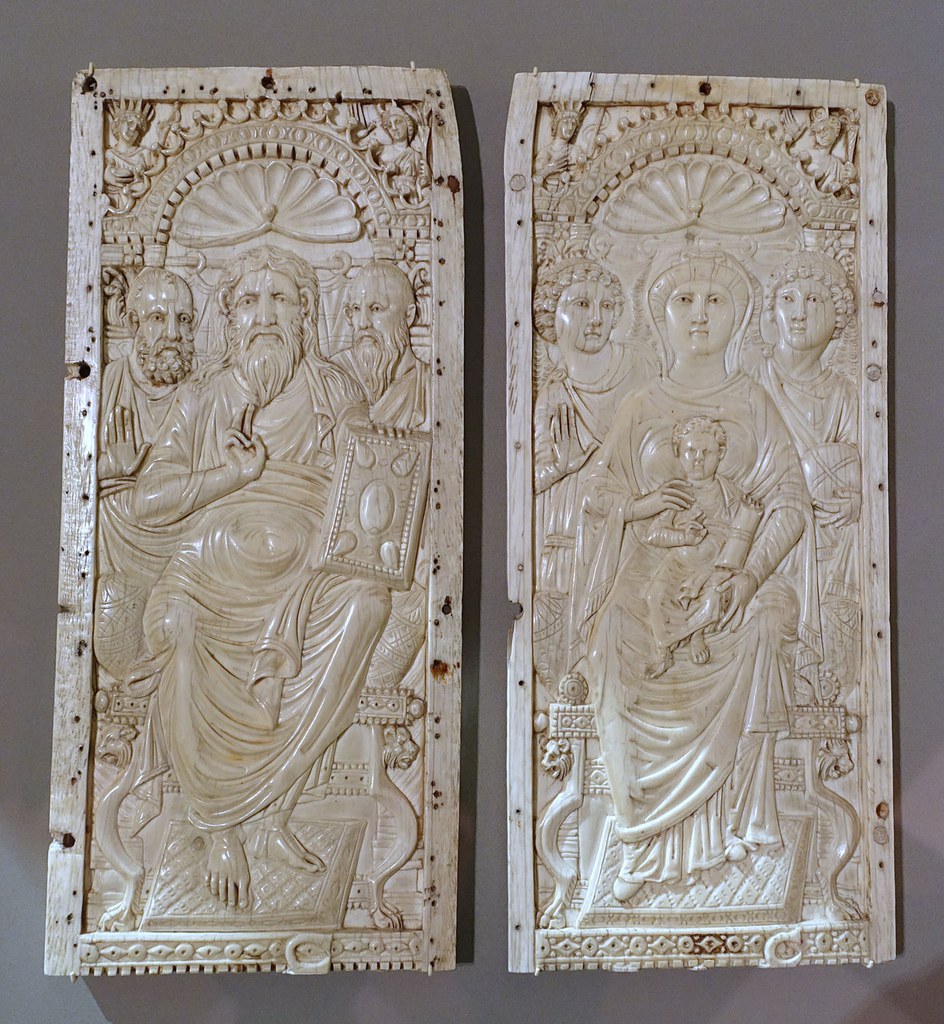
Structurally, the upper fringe of these two curtains cannot be the original limit of the cloth, since the length of a textile would not plausibly hang suspended from a fringe; these are integral warp fringes, not sewn on separately. The original upper support for the curtain’s hanging weight appears to have been a horizontal fold that, when in place, overlapped the upper fringe onto the surface below it. After the pair had ceased to be used as curtains, the fold seems to have been eliminated as unnecessary, allowing the fringe to extend at the top. The modification could have happened recently, or in antiquity when the curtains were chosen for use in the burial of a deceased person. But fringes are not an uncommon feature at the lower ends of curtains, where they do hang logically downward. The fringed lower edge of a curtain may have been more than decorative, if the swaying fringe served the pragmatic function of discouraging flying insects, like the old-fashioned strings of knots or beads still occasionally found in the open doorways of Mediterranean shops without air conditioning. More certainly, there is evidence that fringe was perceived as a sign of elegance and dignity on garments as well as on furnishings. Textile fringes on garments are recorded in various media as a detail signifying high status on earth as well as in the court of heaven. In a sixth-century ivory diptych now in Berlin, the mantle of Mary and the chlamys of the archangel holding an orb are fringed (fig. 3).Staatliche Museen zu Berlin, Skulpturensammlumg und Museum für Byzantinische Kunst, 564, 565: R. Cormack and M. Vassilaki, eds., Byzantium, 330–1453 (London, 2008), no. 25. In fifth-century Egypt, the powerful abbot Shenoute insisted to the nuns making his clothing that he must wear fringe as well as color; he likewise objected to the design of a cloak that allowed tassels to interfere with the fringe.R. Krawiec, Shenoute and the Women of the White Monastery: Egyptian Monasticism in Late Antiquity (Oxford, 2002), 47 and nn152–58, translating Shenoute’s written requests and comments to the female monastics who had been working on his wardrobe and weaving a cloak for him. Shenoute was not isolated by his Theban desert location, or by his position as abbot of the White Monastery at Atripe, Sohag, adhering to the Pachomian rule. In 431 he traveled to represent the orthodox faction at the Council of Ephesus. His comments may therefore reflect established orthodoxy in dress, and carry the weight of his reputation, which extended far beyond the community of about four thousand male and female monastics he ruled for at least eighty years.
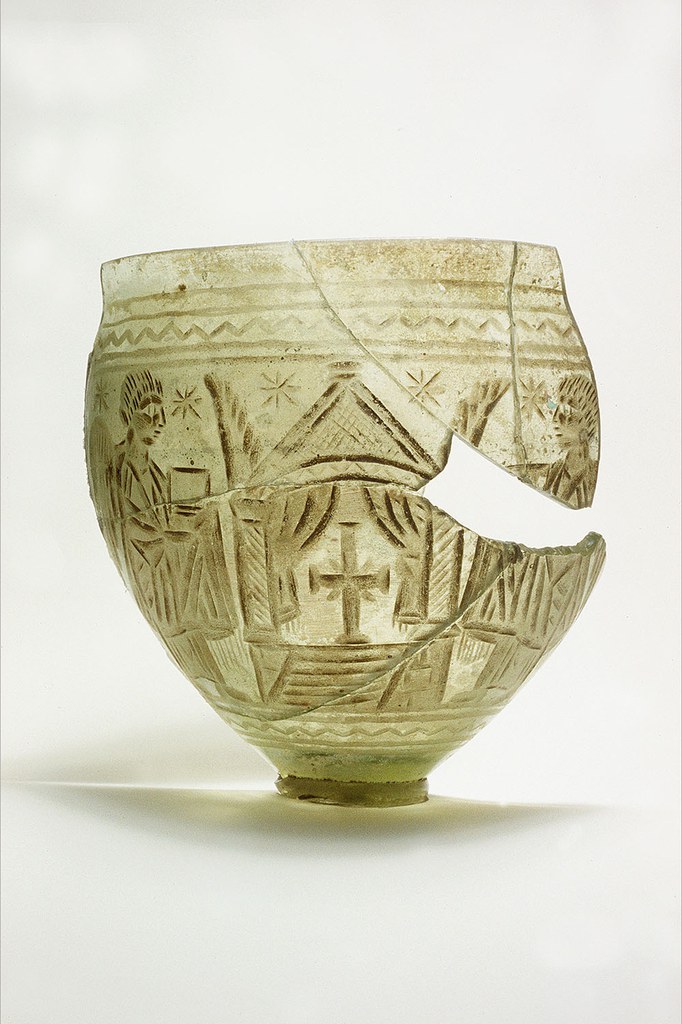
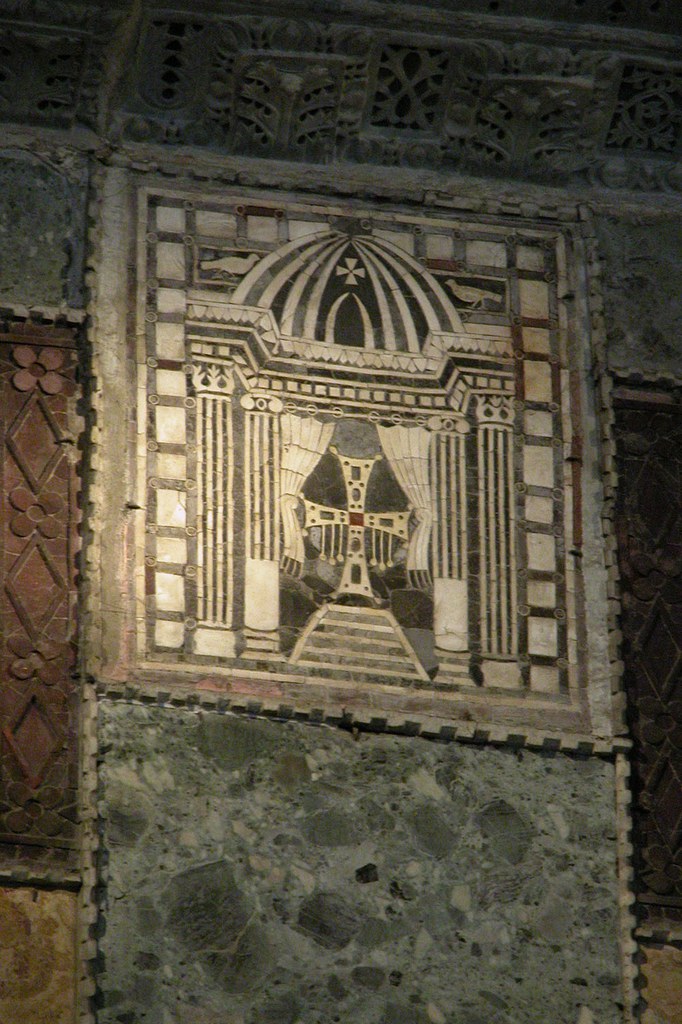
Makers of images often took pains to show fringe on curtains whether the setting was sacred or secular. Fringes edge the curtains that appear, for instance, on a glass chalice at Dumbarton Oaks (fig. 4), on a marble panel at Hagia Sophia with a triumphal cross (fig. 5), and in the empress portrait ivories now in Vienna and Florence.For the Dumbarton Oaks chalice (BZ.1937.21), see M. C. Ross, Catalogue of the Byzantine and Early Mediaeval Antiquities in the Dumbarton Oaks Collection, vol. 1, Metalwork, Ceramics, Glass, Glyptics, Painting (Washington, DC, 1962), no. 96, plate LXV A–B, LV C. See also a photograph elucidated by a drawing clearly showing the wheel-cut details of the curtains, their folds, the border or transverse banding of tapestry or open weave along their lower edge, their central restraints and/or knotting, and their fringe; Y. Israeli and D. Mevorah, Cradle of Christianity (Jerusalem, 2006), 91. The two similar empress ivories are in the collections of the Kunsthistorisches Museum in Vienna (Antikensammlung, X39) and the Bargello Museum in Florence. For the Vienna ivory, see H. Maguire, “From Constantine to Iconoclasm,” in Cormack and Vassilaki, Byzantium, 330–1453, 64, 67, and 84, no. 24. Both panels are illustrated in W. F. Volbach, Elfenbeinarbeiten der Spätantike und des frühen Mittelalters (Mainz, 1952), no. 51 (Bargello) and no. 52, both on plate 13 (Kunsthistorisches Museum). In each case the fringe is clearly indicated on the lower ends of the curtains, which are looped around the columns at shoulder level, whether the empress stands (as in the Florence panel), or sits (as in the Vienna panel). In the dome mosaic of the Rotunda at Thessalonike, individual curtains dripping long red fringe, probably indicating red warp, have been drawn open to the terraced courtyard fountains of a heavenly palace (fig. 9). At Poreč, for the less palatial house of Elizabeth in the Visitation scene, the mosaicist has adorned a door curtain without conspicuous fringe, but given it a red upper border under the corded edge that rises into suspension loops at the top (fig. 6).See the fourth or west panel, featuring Romanos and Eukarpion, and in the northwest panel the green curtains with golden fringe, illustrated in C. Bakirtzis, E. Kourkoutidou-Nikolaidou, and C. Mavropoulou-Tsioumi, Mosaics of Thessaloniki, 4th to 14th Century (Athens, 2012), 111, fig. 70; 81–83, figs. 48–49; 60, fig. 12; 106–9, figs. 68–69. On fountains in palace architecture, see H. Maguire, “The Empress and the Virgin on Display in Sixth-Century Art,” in Proceedings of the 21st International Congress of Byzantine Studies: London, 21–26 August 2006, ed. E. Jeffreys and F. K. Haarer (Aldershot, UK, 2006), 1:385. For the flowered curtain spread in front of the Torah shrine in the Beth Shean mosaic, see Schrenk, “(Wall-)Hangings,” 151, fig. 6. A double line representing blue weft threads (another known feature at the top or bottom of actual textiles), instead of a figured tapestry band or border, defines the uppermost and bottom zones of the curtain.
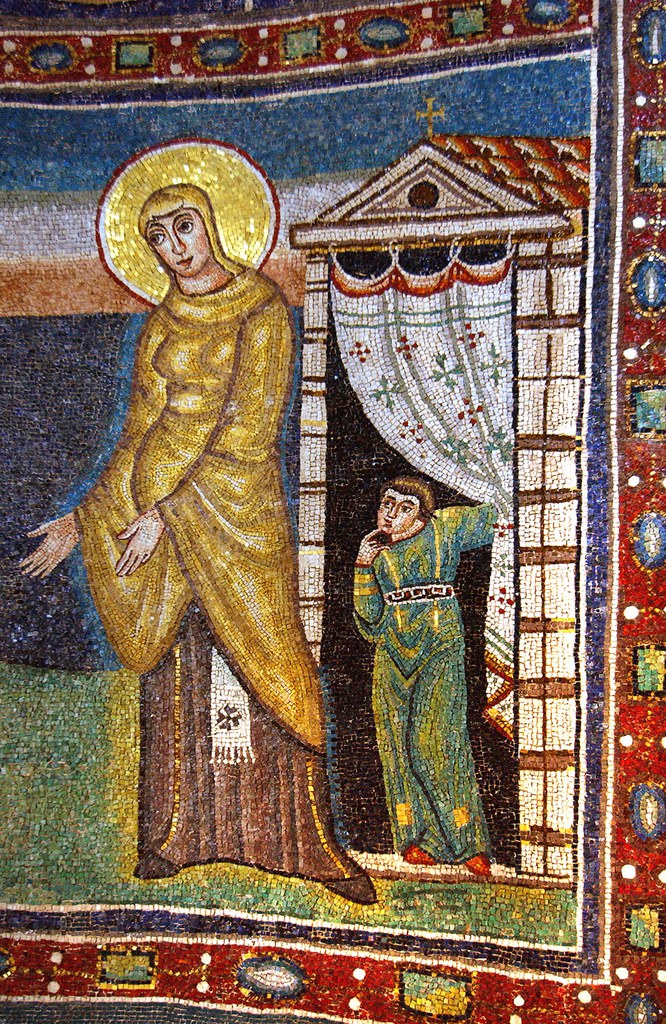
End borders are among the details of curtains depicted in many mosaics. In her analysis of the mosaics in the Samaritan synagogues at El-Khirbe and Khirbet Samara, Sabine Schrenk interpreted these borders of short vertical lines in a row not as the bands of empty warps found at the ends of many actual textiles, but as embroidery; it now seems possible that they may represent fringe along the folded top end of the curtain. Many mosaics also indicate whether the curtain was fixed or sliding at the top. The mosaics at El-Khirbe feature a single fixed curtain in a relatively narrow doorway. The curtain hangs from five unseen hooks on the lintel’s inside face; the single curtain depicted at Khirbet Samara, by contrast, hangs from four rings that would have slid along a rod in front of the door.Schrenk, “(Wall-)Hangings,” 162, figs. 14–17.
A fragment in the Katoen Natie collection in Antwerp retains an open-weave or empty warp band along with a feature that the top of the British Museum curtains lacks.Antwerp, Katoen Natie, 1743: C. Verhecken-Lammens, “Linen Furnishing Textiles with Pile in the Collection of Katoen Natie,” in De Moor and Fluck, Clothing the House, 132–34 (for empty warp), and, for this example of it, together with the reinforced band of sturdier weave and a set of loops for hanging, 142–43, fig. 14; see also Stephenson, “Veiling.” Such a loose unwoven or bare-warp zone is unexplained. Especially if it separates the top of the textile from the length below, it looks like an intrinsic weakness in the design, the absence of weft making the loose warp vulnerable to the stress of gravity just below the points of suspension. On the Antwerp textile, above this open-weave band, the warp is tight, reinforced with a heavy-gauge or double weft, creating a densely woven, sturdily structured zone, corded along its upper edge, to support the suspension loops. Below the upper fringe on the British Museum curtains, a structural reinforcement of self-striping remains where several grouped linen wefts, spaced to form narrow bands of varying thickness, provide a ribbed structure to strengthen the width of the textile across the top. These narrow bands of ribbing are visible in relief to the naked eye, while in recent photographs they appear as striations slightly darker than the field of plain weave.The self-striping at the bottom end of the British Museum curtain is visible in a recent photograph: http://www.britishmuseum.org/research/collection_online/collection_object_details/collection_image_gallery.aspx?partid=1&assetid=24165001&objectid=109404. For self-striping, also called self-bands or self-banding, see E. D. Maguire, Weavings from Roman, Byzantine and Islamic Egypt: The Rich Life and the Dance (Champaign, IL, 1999), 16–17, and nos. A2, A29. See also Fluck, Helmecke, and O’Connell, Egypt: Faith After the Pharaohs, 106, no. 114, for the British Museum joined pair (EA29771): unlike the “red applied cord” at the opening between them, the self-striping at the top runs horizontally between the red-ground tapestry border and the fringe. Self-striping is more clearly illustrated, with good technical descriptions, in F. Calament and M. Durand, eds., Antinoé, à la vie, à la mode: Visions d’élégance dans les solitudes (Lyon, 2013), no. 85, detail on p. 245; no. 125, detail on p. 312; and no. 82 (cf. no. 136 from the famous tomb of Thaïs, whose hair and clothing yielded a radiocarbon terminus ante quem of the second half of the seventh century).
More Technical Considerations and Alternatives
In our hypothetical reconstruction, the London curtains would have had a fold at the upper edge, above the hanging fringe seen at the top in the most recent photographs. At present, the tops of the curtains, carefully reinforced with a new backing strip, offer no evidence of how many loops were provided for hanging. But the horizontal and unmoving register across the top of the joined curtains indicates the likely employment of a shared central point of suspension. Such a scenario corresponds with the evidence provided by surviving sets of hooks on the outer lintels of monumental early Byzantine doorways. The hooks are evenly spaced and set in odd rather than even numbers. Alignment with the central hook, and suspension from it, would have determined the shared central axis above the curtains’ parting. This fixed center would have stabilized the textile even when the lower ends of a joined curtain pair were pulled away from one another to the sides of the door frame, or whatever opening the curtains filled.

The finger-shaped bronze hooks on the exteriors of the Hagia Sophia narthex and exonarthex doors conform to the pattern of odd numbers of suspension points, so that, whatever design features distinguished the curtains that once hung there, we can imagine them configured as pairs joined together at the top and hanging from the west or outer face of the lintel, in front of the valves of each door (figs. 7a–b).For views of the Hagia Sophia narthex and exonarthex doors including some of their fittings, see C. A. Mango, Hagia Sophia: A Vision for Empires (Istanbul, 1997), 11, 14–19. For the finger-hooks on the outer narthex doors, see http://id.lib.harvard.edu/images/olvwork480110/urn-3:DOAK.LIB:3708841/catalog. The face of the lintel above the main west door of the basilica of Eufrasius at Poreč also retains an odd number of finger-hooks; Terry and Maguire, Dynamic Splendor, fig. 204. For the hooks supporting the joined tribelon curtain depicted in the Sant’Apollinare Nuovo mosaic of Theodoric’s palace (to be further discussed below), see Stephenson, “Veiling,” 21, fig. 20. For finger-hooks as objects, see E. D. Maguire, H. Maguire, and M. Duncan-Flowers, Art and Holy Powers in the Early Christian House (Urbana, IL, 1989), 45; for an example with a cross as a fixture (University of Toronto, Malcove Collection, M82.416), ibid., 50, no. 3. For the curtains depicted in the dome mosaic of the Rotunda at Thessalonike, see Bakirtzis, Kourkoutidou-Nikolaidou, and Mavropoulou-Tsioumi, Mosaics of Thessaloniki, 64–65 (for a drawing of the whole dome program), and 61, fig. 23 (showing below, a curtain hanging on rings around two finger-hooks, and above, a curtain hanging on rings around a rod). For the curtains’ selective mobility further contributing to their presentation as architectural accessories, see ibid., 91, fig. 53 (where the curtains are looped around columns), and 95, fig. 57 (where support is provided by a red loop hanging from a hidden hook or bracket). The close-up view of the standing Therinos (ibid., 98, fig. 59) and other detailed vies appear to show a large, dark hook bent up at an angle, like the finger-hooks on lintels, and perhaps a red cord holding the curtain’s weight against the column, details that may yield more information through on-site examination. In some cases of tied-back curtains, this one-point support may have been supplemented by lateral ties attached to the curtain itself. Such ties would also have helped to hold an unbound curtain in place; see Fluck, “Use of Textiles,” 259–60. Given that curtain pairs joined at the top like the British Museum’s were designed for fixed mobility and supported by hooks but easily parted below, a central pictorial focus shared by the two curtains makes good design sense. Not many surviving works of art depict joined pairs of curtains, so we cannot rely on artistic sources to determine a full range of locations where such curtains would have been displayed and used. One apparently joined pair is centered over the altar in the Ashburnham Pentateuch’s scene representing the Tabernacle of Moses as a Christian sanctuary (fig. 14). This scene, and another of the Tabernacle courtyard (fol. 127v) illustrate a wide variety of hanging and draping of curtains and canopy, as well as the ceremonial opening of two curtains, probably reflecting sixth-century practice.
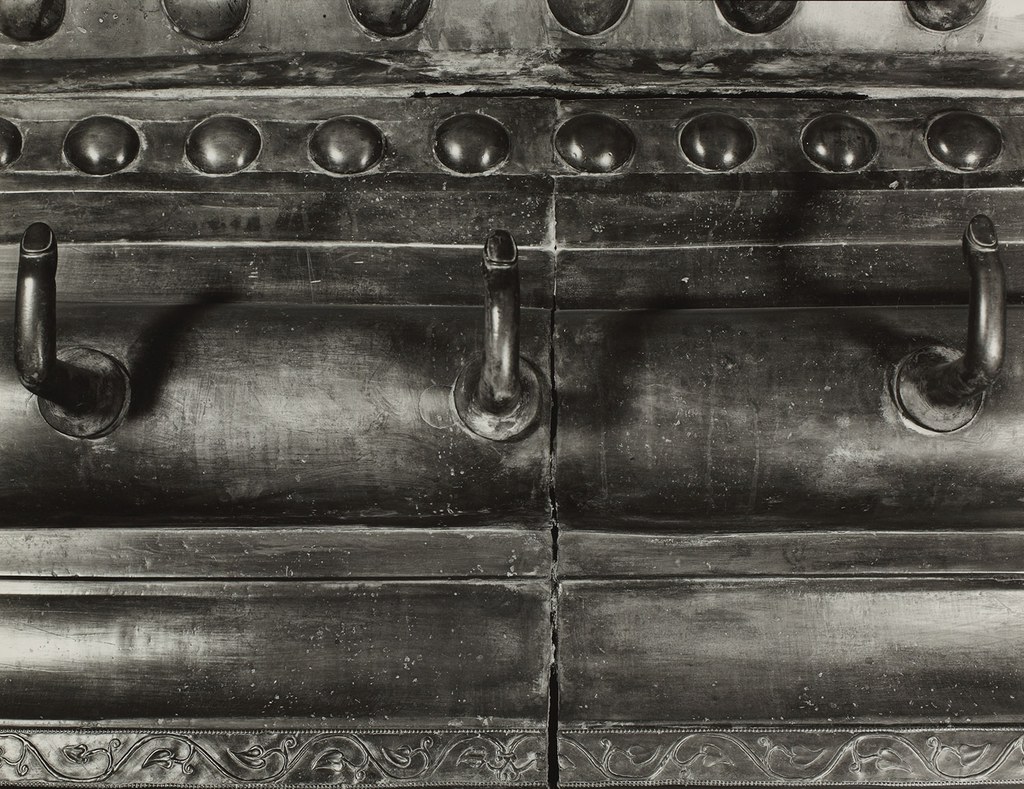
Plain or figured, joined curtain pairs were too versatile to be restricted to architectural use for the regulation of light, of visibility, or of access Such curtains were made for both indoor and outdoor use, as their presence implied by the odd numbers of hooks on the outside of exterior doorways indicates. They would also have been useful outdoors, in the woods or fields, or even in a garden, to give shade and to define space. An engraving on a large fourth-century silver and niello plate or tray found in Cesena, south of Ravenna, depicts a pair of curtains functioning as a sun-shading canopy; they are shown pulled forward like a divided awning with draped ends supported on trees. This looped and gathered textile frames a group of five hunters dining on the ground.Cesena, Biblioteca Malatestiana: K. Weitzmann, ed., Age of Spirituality: Late Antique and Early Christian Art, Third to Seventh Century; Catalogue of the Exhibition at the Metropolitan Museum of Art (New York, 1977), 275–76, no. 251a; Josepha Weitzmann-Fiedler here credibly suggests a late fourth-century date, and although believing that “the trees and a drawn curtain indicate that the setting is a tent in the open” (276), interprets the feast setting as if it were indoors, with a stibadium (rather than cushions on the ground around a tray on a draped stand). Yet it could be, as she suggests, that a tent would have supported the upper edge of the joined curtains depicted on the plate, allowing them to extend outward and be attached to trees; for such a canopy at the back of a much later tent scene, see Johan Zoffany’s painting Colonel Mordaunt’s Cock Match, ca. 1784–86, Tate Gallery, T06856, https://www.tate.org.uk/art/artworks/zoffany-colonel-mordaunts-cock-match-t06856: Artist and Empire: Facing Britain’s Imperial Past, ed. A. Smith, D. B. Brown, and C. Jacobi (London, 2015), 164. The scene can be compared with the hunters’ feast depicted on a silver plate in the Sevso treasure, but there the canopy hangs from a ridgepole, so that instead of resembling curtains, it is shaped like the roof of a basilica. In both scenes large textiles are tied to trees for the benefit of the diners, setting them apart from the servers. The curtained canopy depicted on the Cesena plate produces a flattering frame. Other furnishing textiles are recorded in the outdoor feast scenes on these silver plates. A cloth, for instance, drapes the legs of the stand that appears to hold a round serving plate or tray-top on the Cesena picnic table, completely covering the top of the tablecloth (unless what looks like the rim of a tray is actually a hoop around the edge of the round table, securing the tablecloth from being carried off by the wind or by a hunter’s hound). The hunters of the Sevso scene recline at this outdoor stibadium on striped or banded bolster-shaped cushions set in a curve. The presence of these accessories in both scenes bears witness to the importance of textiles in the social environment, while the abstract but recognizable detail of a canopy constructed like a joined pair of curtains suggests that such things were familiar furnishings.
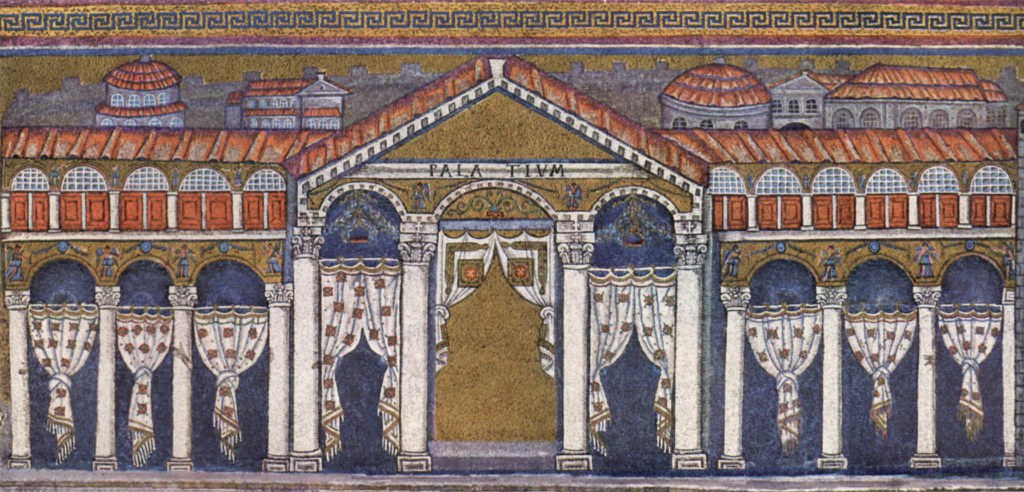
Joined curtain pairs, which worked well for spanning large spaces or for imparting an element of grandeur to an entrance of any size, also appear in the mosaic representing Theodoric’s palace at Sant’Apollinare Nuovo in Ravenna (fig. 8), not far from Cesena, where the silver plate was found along with an Ostrogothic coin dating about a century before Theodoric. A central parting distinguishes all three curtain pairs of the majestic central tribelon, the three-arched entrance to the palace. Here the curtains play a strong architectural role, strengthening the reference to a three-part triumphal arch by lowering the perceived height of the central entrance in relation to the other two. The central pair of curtains, which spans the widest of the arches, is suspended from five finger-like hooks under the tympanum to keep the curtains from sliding to either side. The vines scrolling left and right on the tympanum itself and the division into two halves of the inscribed word above it, PALATIVM, visually accentuate the gestural symmetry of the two curtains below: they are effectively separated but interdependent, like the garland-bearing Victories who flank the central opening of the British Museum curtains, reinforcing the suggestion, in the mosaic image, of a triumphal arch. Extended horizontally and held in place at the top by the hooks, each curtain is drawn back and up along its length, pulled into a knot-like bulge held against a column. Only this central curtain pair is designed with the self-framing geometry of bracketing gammadia (as the inverted or upright L-shapes are often called) at the top.The compositional power of the gammadion as an enclosing motif is discussed in Jennifer Ball’s discussion of a Dumbarton Oaks textile fragment, BZ.1943.8, “Rich Interiors: The Remnant of a Hanging from Late Antique Egypt in the Collection of Dumbarton Oaks.” In the Sant’Apollinare Nuovo mosaic, each of the central curtains may be imagined as large enough to have been folded in half vertically, so as to present the same appearance from both sides. That would mean each had four corner-defining brackets, with a panel embraced by each bracket, the lower panels and brackets being mostly hidden by the folds; such curtains may also have had a central panel or medallion to mark the spot for gathering. This contrasts, for example, with the depiction of curtains in the mosaic between the apse windows at Sant’Apollinare in Classe. The bishops stand before the tied-back curtains of niches that conceptually extend the actual space; these curtains are evidently not folded double, since the corner brackets and panels are shown, back to back at the top, where the curtains nearly meet. The distinction between the central curtains of the palace entrance and the honorific curtains of the niches where crowns hang from the curtain rods, in the apse mosaic may be that the curtains of a niche, being seen from the front only, had no need to be folded double. The details of the curtains in the Sant’Apollinare in Classe mosaic are clearly seen in these photographs: https://commons.wikimedia.org/wiki/Sant%27Apollinare_in_Classe#/media/File:Saint_Severus_of_Ravenna_mosaic_-_Sant%27Apollinare_in_Classe_-_Ravenna_2016.jpg; https://commons.wikimedia.org/wiki/File:Ravenna,_basilica_di_Sant%27Apollinare_in_Classe_(050).jpg; https://commons.wikimedia.org/wiki/Sant%27Apollinare_in_Classe#/media/File:Saint_Ecclesius_of_Ravenna_mosaic_-_Sant%27Apollinare_in_Classe_-_Ravenna_2016.jpg. Each of these brackets encloses a square panel with a single rosette, in an arrangement that emphasizes the uniquely high passageway between the parted curtains for ceremonial entrances and exits. The three sets of curtains and their differences are the more conspicuous for making a discontinuous horizontal sequence, pairing the side arches as subsidiary to the central one, even though the three arches are of equal height. The central curtain pair is not only knotted higher up than the two joined pairs that hang in the side arches of the tribelon, it is also shorter, leaving more open space between the columns, to better display the comings and goings of those passing through the central portal.
The two side pairs of curtains contrast with the central pair in their allover patterning as well as their lower positioning. Although their tops are joined, the joining continues much farther down the curtain than on the central pair, leaving a smaller opening for passage. They hang on rings or loops from five suspension points, on rods set between the necking rings of the column capitals, rather than at impost level. The curtains’ joined centers are unified by the repeating pattern that continues down to their fringed ends, close to the ground. Each of these two pairs, parting at a relatively low level, creates an ogival opening that in comparison with the opening between the higher central curtains would diminish the status of anyone passing through. Instead of being knotted or looped, they are simply gathered back against the column shafts. As if ready to be closed, they are loosely held by bracket-like tie-back fixtures, analogous in their angularity to individual finger-hooks but much larger. These fixtures appear a little less than halfway up the shafts, just at the level where one of the “disembodied” hands of a hidden figure appears.H. Maguire, “The Disembodied Hand, the Prokypsis, and the Templon Screen,” in Αναθέματα εορτικά: Studies in Honor of Thomas F. Mathews, ed. J. D. Alchermes (Mainz, 2009), 230–35. Even the hardware of these half-hidden tie-backs conforms to the lesser status of the tribelon’s side arches in comparison with the central arch: the grayish blue tesserae of the fixtures in the lower arches suggest that they are made of lead, while the hooks on the lintel are rendered in brown tones, suggesting copper alloy.
All three of the centrally parted pairs of curtains adorning the tribelon invite the controlled passage of light, while the shapes of their openings would frame the elite persons admitted into the palace, sorting them according to rank. By contrast, the single curtains of the portico on either side of the entrance are gathered and centrally knotted to provide a screening effect that would have allowed light to enter mainly from below the upper, unrestrained bulk of the curtain, while hiding most of the activity within from outsiders.
All the palace curtains in the mosaic show textiles without figural imagery, although the mosaicist has respected the power of the colored patterns on all the curtains to order their disposition in relation to one another and to the arches that frame them. The brackets and square panels on the central curtains display the big, single stylized roses at the top, while in the lower half of each curtain what seems to be the same configuration has been made only marginally visible, as if its details were lost in the gathered folds whose positioning these lower brackets and panels helped to guide. In the side arches of the tribelon the curtains are patterned with an allover scatter of rose-medallions, in staggered rows. Similar rose-medallions on the portico curtains are not staggered, but aligned in two horizontal rows above the knot, and lined up vertically below the knot to indicate the centering of the fold. Except on the special central pair, horizontal borders, representing perhaps the overlap created by a suspension fold, or else a sturdily-woven suspension zone, mark their upper edges across the full span of the arch. Since all these features correspond to details found on actual textiles, it is likely that woven patterning similarly helped with the arrangement of curtains when they were hung in space.
At Poreč, the door curtain in the apse mosaic’s portrait of Eufrasius shows an even number of suspension points supporting a single curtain. This departs from the evidence at the actual entrance to the nave for the presence of a joined pair of curtains, rather than a single curtain, there. The lintel of the door retains an odd number of hooks. Was the mosaicist, working perhaps as the nave was being built, unaware of the actual curtain fittings? Did he assume that the depiction of a single curtain would be easier to see and understand from a distance? Did he seek to give the impression of a very large and sumptuous curtain as part of the bishop’s gift? Any one of these explanations is possible, while the information in the mosaic must be received with a caveat against taking narrative or dedicatory scenes as strictly documentary.
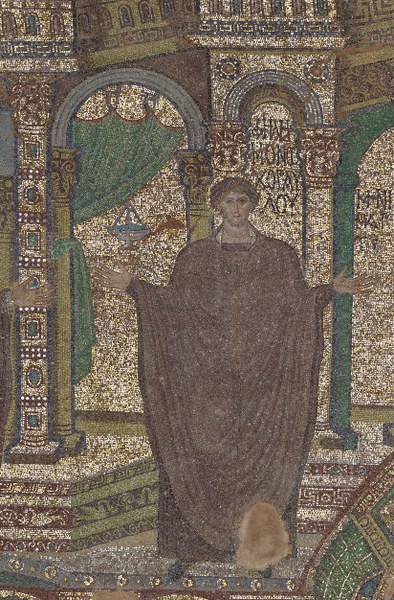
In one of the visionary architectural pavilions of the Thessalonike Rotunda dome mosaic, two silvery hooks facing outward support an undivided curtain outside an arch between Saints Leon and Philemon (fig. 9). This detail suggests the luxury of casual passage between elegantly designed indoor and outdoor spaces, as opposed to the grandeur of official entrances such as the Justinianic doorways at Hagia Sophia. In buildings where curtains spanned archways or crossed open spaces, transverse rods were most convenient; the ciborium at Poreč, remade in the thirteenth century, may incorporate, across its four arches at the level of the capitals, the rods that supported the curtains of its Byzantine predecessor. Since rods were not connected to the curve of the arch but instead cut across it, they allowed curtains to be slid to the side. Hooks embedded in the arch would put more stress on the upper part of a curtain in frequent use. The special hardware affixed to the columns or walls against which a curtain was restrained spared the curtain fabric from having an actual knot tied in it; such hardware, rarely found in situ, deserves further study.
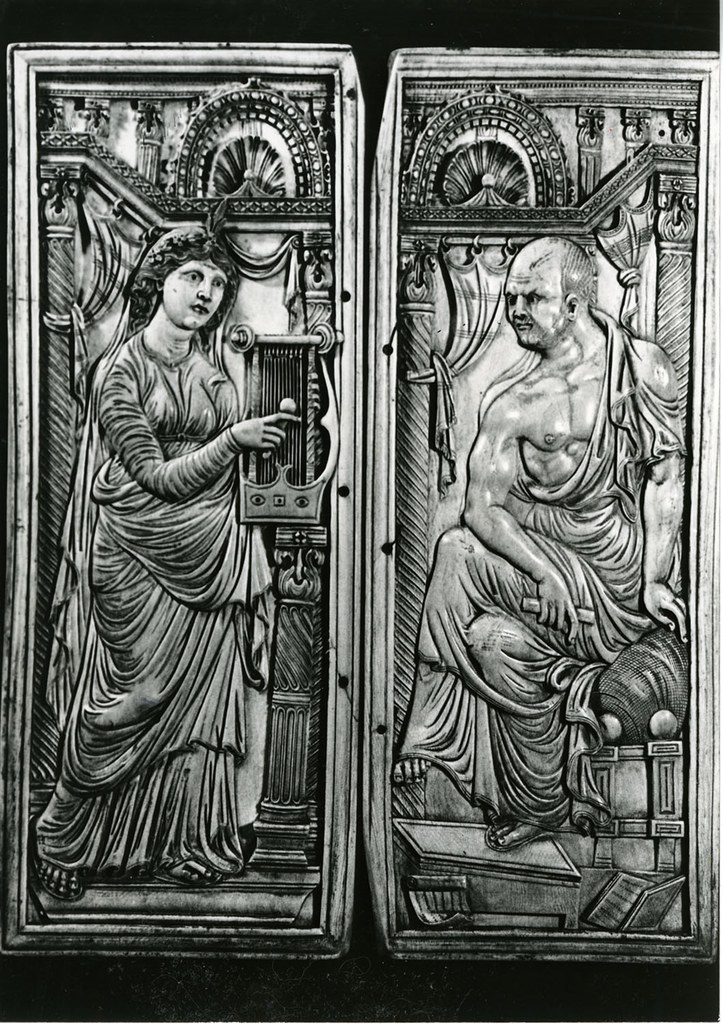
A privileged view of the inside of an ornately curtained secular space is offered by an ivory diptych in the cathedral treasury, which probably dates to the first half of the fifth century (fig. 10).A. Cutler, “Five Lessons in Late Roman Ivory,” in Late Antique and Byzantine Ivory Carving (Aldershot, UK, 1998), 16–19, fig. 23; warm thanks are due to Professor Cutler for providing his photograph; K. J. Shelton, “The Consular Muse of Flavius Constantius,” ArtB 65, no. 1 (1983): 7–23. Although the diptych is customarily called “poet and muse,” the mantle exposing half of the seated figure’s bare upper torso, and his bald head place him in portrait tradition of Socrates; see P. Zanker, The Mask of Socrates: The Image of the Intellectual in Antiquity, trans. A. Shapiro (Berkeley, 1995), 59–60, figs. 33 and 150, and for discussion of poets, philosophers and “amateur intellectuals” represented with muses who may embody their wives, 272–78. Zanker, sees the figure on this ivory as a poet, and suggests that the conspicuous soft furnishing of the cushion is a poet’s attribute (142–43, 328). It represents, in a kind of open alcove, an intimate though allegorical scene of intellectual luxury: a woman in the guise of a lyre-playing muse standing on a plinth before a man seated in the conventional pose of the poet or philosopher, for whom she sings. Around the sides, making a chamber of the space, hang single curtains, one in each intercolumniation, the corner columns being wholly (for the female figure) or partly (for the man) concealed behind the figures’ heads.The space has a sacred parallel in the trabeated enclosure surrounding the tomb of Saint Peter in the Constantinian apse of the Vatican basilica, which featured curtains hung in pairs between ornate columns. In its depiction of Old St. Peter’s, the ivory carving of the Pola casket shows, in addition to the four central columns supporting the ciborium, two additional pairs of columns to the left and right with curtains hung between them to screen off the apse. J. J. Emerick, “Altars Personified: The Cult of the Saints and the Chapel System in Pope Paschal I’s S. Prassede (817–819),” in Archaeology in Architecture: Studies in Honor of Cecil L. Striker, ed. J. J. Emerick and D. M. Deliyannis (Mainz, 2005), 43–46, figs. 3 and 6. The curtains are hung from trabeations in three different ways, as if to demonstrate a repertory of curtain-hanging strategies. Their accuracy as exemplars for curtain suspension modes is supported by another realistic furnishing, the textile cover on the poet’s bolster-like seat cushion. Its carved weave-like pattern has creases across it, and a shaped end-seam.
Two of the curtains—one visible just over the right shoulder of the muse, the other over the right shoulder of the poet—hang from rods secured between the abaci of the column capitals, Three large, sliding rings for each of these two curtains link into smaller suspension rings attached to the curtain, apparently by sewing. The tops of these curtains run parallel to the architrave, while the hanging ends have been pulled aside and wrapped once around the shaft of a column. Such an arrangement would presumably be supported by a fixture hidden behind the column. Ribbed borders along these curtains’ tops are faithfully recorded, as are thin transverse stripes, shown as triple incised lines in evenly spaced sets repeated all the way down to the softly fringed end. Between the two personages, immediately to the right of the muse’s head, is a plain curtain hung horizontally like a canopy, as if to span the space between the figures on their separate wings of the diptych. It curves in a relaxed swag from a hidden suspension point at the left under the architrave. Its gathered length is tucked over a fixture terminating in a disc with a flat circular knob at its center, below the architrave, at the abacus level of the capital to the right; the lower end of this curtain, fringed like the two main hanging curtains, dangles in folds.Actual fixtures used for the purpose of holding the lower ends of curtains up or back remain to be identified. See above, n18 for red cords suspending the gathers, in the Thessalonike Rotunda mosaic. Hardware in the wall beside the doors in the inner narthex at Hagia Sophia appears to have been related to this purpose, and more than one copper alloy fixture in museum collections is a possible candidate for this function. No textile designed to display horizontal imagery across the top would be suitably hung in such a fashion. The third curtain-hanging strategy in this diptych is equally suited to a single curtain rather than a pair. The knotted curtain spread behind the poet’s head hangs vertically, deeply cusped by tension at three fixed points of suspension hidden behind the architrave. Across its top, the edge is textured in the carving by beading, or pearl-like pellets in relief, perhaps representing a “pearl” border copied from Persian silks. Below the edge border a wide horizontal band textured by cross-hatching enriches the curtain’s surface with its contrast. This curtain is knotted high up, resulting in a bulging, funnel-like outline. The height of the knotting, raising the plainly ribbed lower end to the man’s shoulder level, suggests a decorative and honorific screening function, as well as a practical means of either blocking noonday glare or letting in the low sunshine of morning or evening, along with a cooling breeze.
Experiencing Curtains and Their Themes
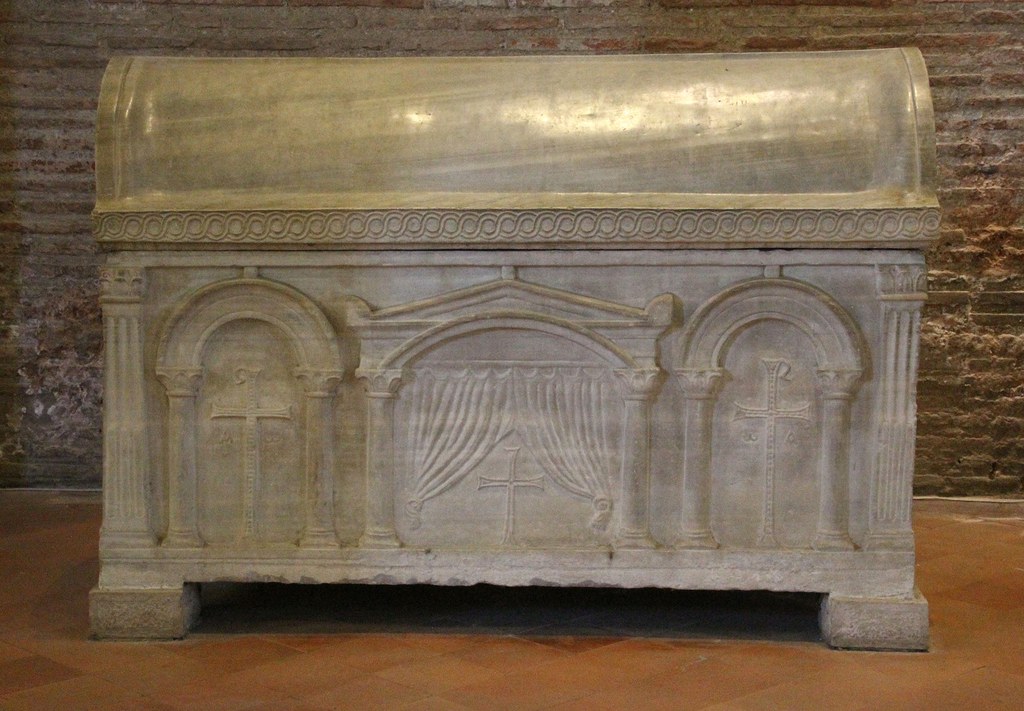
The primary theme of Christian triumph and salvation on the British Museum curtain pair includes varied and reiterated motifs of peace and prosperity, making the curtains a fitting accessory for protocol and ceremony. Many actual curtain fragments, as well as depicted curtains, with or without any imagery on them, express these themes. A fringed pair of joined curtains, suspended vertically, parts above the central cross on a marble sarcophagus in Sant’Apollinare in Classe (fig. 11).R. Farioli, Ravenna romana e bizantina (Ravenna, 1977), figs. 78, 174; G. Bovini, Ravenna (New York, 1973), fig. 116, clearly shows the joining of these curtains, which are fixed to a rod or lintel from nine suspension points above the cross. Also visible are the ornamental terminal knobs around which the curtains are wrapped to secure their parted ends, and their fringe; unfortunately, the carving’s realism stops short of showing how the knobs were attached to the columns or the wall behind. Although there is no inscription on this sarcophagus, the architectural framework argues for a possible fifth century date. Another joined curtain pair enhancing a sacred scene is the one parted over the altar in one of the two views of the Tabernacle and its curtains in the Ashburnham Pentateuch.In the Ashburnham Pentateuch (Paris, BnF, Ms. Nouv. acq. lat. 2334), fol. 76r illustrates three apparently different suspension systems for the curtains and canopy of the Tabernacle imagined as a Christian chancel. Wide textile loops appear to be integral to the colored border of the two white curtains, while rings, probably of metal, on slender rods or cords hold a set of reddish curtains arranged in-line with the altar, to its left and right, and folded under and back to hang festooned in bellied swags. A hardware suspension system, perhaps of hooks, appears to be disguised by knobs for the individually colored curtains fastened against the columns, one per bay, as well as for an inverted, undyed canopy hung in gathers overhead from a pair of long rods. Still more varieties of hanging and draping curtains are illustrated in another scene in this manuscript, around and at the entrances to the Tabernacle courtyard (fol. 127v), probably reflecting sixth-century practices. See D. H. Verkerk “Exodus and Easter Vigil in the Ashburnham Pentateuch,” ArtB 77, no. 1 (1995): 94–105; and H. L. Kessler, Spiritual Seeing: Picturing God’s Invisibility in Medieval Art (Philadelphia, 2000), 170, fig. 17.16; and the online facsimile, https://gallica.bnf.fr/ark:/12148/btv1b53019392c. For strings attached to the long sides of curtains were one means of fastening them against vertical supports, see n17 above. These curtains, which add drama to the compositions with a soft gestural grace of symmetry, are bare of imagery. But even without a shared pictorial program like the one across the top of the British Museum pair, plain curtains by their structure and installation could have enabled Gregory to allegorize the spiritual joining of liminal units in terms of the Tabernacle’s two sets of five joined curtains, which signify to him the “harmony, love, and peace of believers.Vita Moysis 2.186, cf. Ps. 147:14; see Conway-Jones, Tabernacle Imagery, 157, and the two translations cited in n6 above. Strings attached to a curtain’s long side were one means of fastening it against a vertical support: Fluck, “Use of Textiles,” 259–60. His reference to the mystical psalm image of borders made of peace is conceptually closer to the imagery woven into the British Museum curtains. Just above the triumphal central vision, the curtains’ horizontal frieze displays a dancing chorus line of nude allegorical children bearing garlands between them (fig. 12). They are woven in the dark purple color that denotes luxury, and would make them stand out against the light. The red border above them, directly under the lost suspension system, is occupied by an undulating vine stem and smaller-scale symbols of peace and prosperity. Here, nimbed erotes freed from gravity, as if they were flying, bear vessels or garlands; colorful birds and hunting leopards (as cheetahs were called before the Indian name came into English) wearing collars appear, alluding to gardens and game preserves; and footed golden bowls or baskets of fruit or flowers are suspended to offer their contents. All these subjects, seemingly in themselves secular delights pleasing multiple senses, are qualified by the central presentation of the cross.
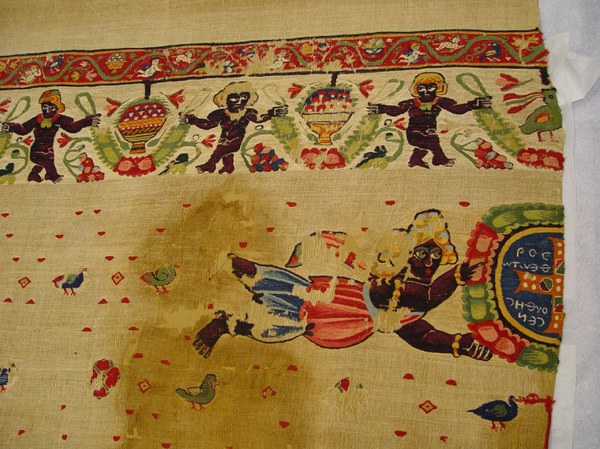
Clearly, curtaining could offer something more than the implied restraint of persons or the convenient blocking-off of a view. Curtains were indispensable in Byzantine court practice, and were used for the staging of protocol in the Great Palace in Constantinople, especially in the Chrysotriklinos, its magnificent reception hall. The ceremonial role of curtains has been proposed as a driver of the architectural design of the Chrysotriklinos, which was built as an octagonal space with seven curtained entrances, each a vaulted space serving to extend one side of the octagon, while the eighth side opened into an apse where the emperor was enthroned.J. M. Featherstone, “The Great Palace as Reflected in the De Cerimoniis,” in Visualisierungen von Herrschaft: Frühmittelalterliche Residenzen; Gestalt und Zeremoniell, ed. F. A. Bauer (Istanbul, 2006), 47–61; See also M. G. Parani, “Mediating Presence: Curtains in Middle and Late Byzantine Imperial Ceremonial and Portraiture,” BMGS 42, no. 1 (2018): 1–25. The structure proved so well suited to its purposes that it was further embellished and expanded to serve successive emperors, and associated with nearby assembly halls. The seven vaulted entrances served as passageways or waiting rooms across which curtains hung to separate them from the central chamber. They were closed and opened in turn according to a carefully choreographed protocol. The tenth-century Book of Ceremonies uses the architectural designation camerai for these spaces, but also, in an impressive metonymy, describes them as bela, or curtains, for the textiles that masked their access. And, as J. M. Featherstone has observed in surprise, the great early ceremonial space within the palace designated as the consistory sheds its proper name in book two, chapter 15 of the Book of Ceremonies, where it is four times designated merely by this descriptive name: the “hall where the canopy stands and the magistroi are promoted.”Featherstone, “Great Palace,” 50, and idem, “De Cerimoniis and the Great Palace,” in The Byzantine World, ed. P. Stephenson (Abingdon, UK, 2010), 165.
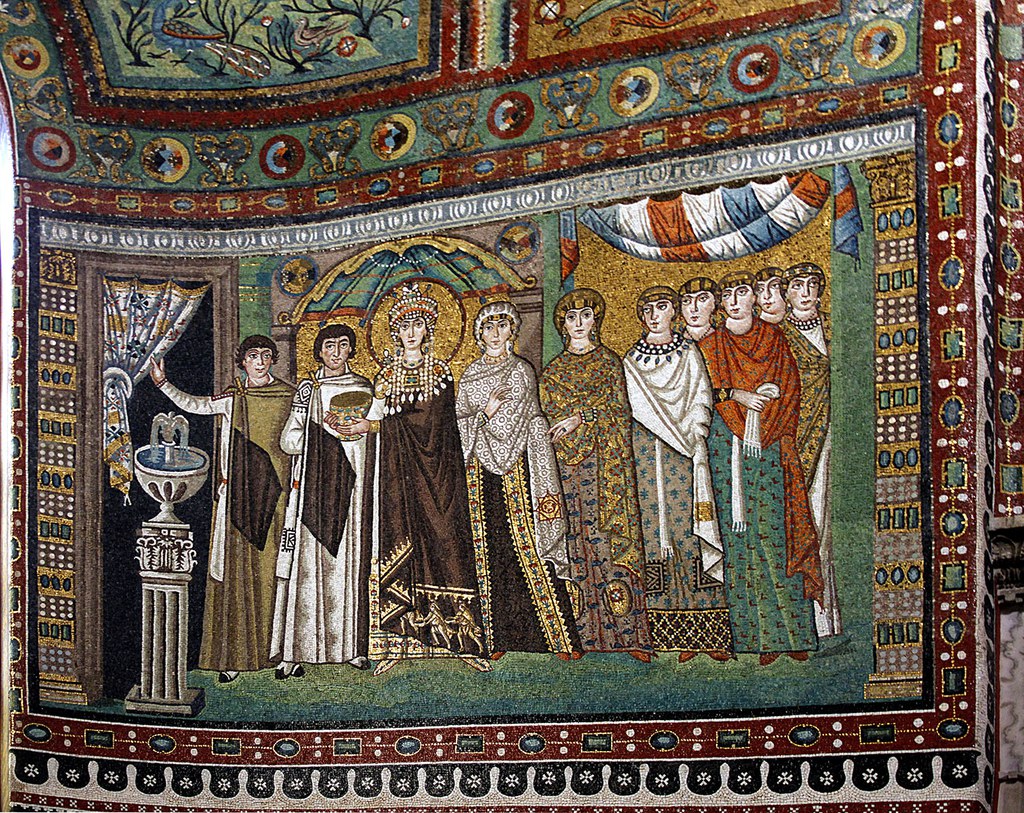
The imperial dazzle of the Chrysotriklinos extended beyond the fabric of the curtains to the special provision of silver rods or beams for their suspension, as mentioned in the mid-tenth century; possibly these silver supports were brackets for holding up the lower ends of opened curtains, but without a clue to their size, their exact nature is unclear.C. Angelidi, “Designing Receptions in the Palace (De Cerimoniis 2.15),” in Court Ceremonies and Rituals of Power in Byzantium and the Medieval Mediterranean: Comparative Perspectives, ed. A. Beihammer, S. Constantinou, and M. Parani (Leiden, 2013), 481 and n54. For state occasions, when silver fixtures could have been used at focal points, reliable restraints—hooks, rods, brackets, or fixtures through which cords for tie-backs could be threaded—would have been needed to support the weight of drawn-back curtains or of canopies. One example of a court canopy is the striped awning above Theodora’s court ladies in the San Vitale mosaic (fig. 13). Draped between columns or pilasters, it hangs cupped or bellied in a downward curve, from hidden fixtures all along one edge and above its gathered, dangling ends. The details of the Monza diptych hint at the importance of the supporting hardware and represent the curtains more convincingly than the architectural embellishments of the upper story. Special fixtures would have been needed to hold open the green textile canopy under which Saint Demetrios presents himself in front of his shrine in a mosaic in his eponymous Thessalonike church where that shrine actually stood. All these space-filling, eye-catching, and enclosing or framing textiles clearly depend on hidden fixtures for the visual and functional variety of their arrangement in particular settings.For this diptych and its cultural context, see Shelton, “Consular Muse,” 18 and fig. 10. For Hagios Demetrios, see Bakirtzis, Kourkoutidou-Nikolaidou, and Mavropoulou-Tsioumi, Mosaics of Thessaloniki, 144, figs. 21–22. The notched yellow border on the canopy may be an applied edging, perhaps clumped fringe.
Such a fixture can occasionally be glimpsed in a mosaic. The white metal of brackets, wide enough to hold the full bulk of a gathered curtain, recorded in silvery-blue tesserae and projecting from columns of the tribelon into the lesser entranceways to Theodoric’s palace as depicted at Sant’Apollinare Nuovo has already been mentioned. A later, apparently bronze fixture angled outward can be seen socketed into the door jamb of Anna’s house in the scene of the angel’s annunciation to her in a well-known mosaic in the monastic church at Daphni; this exposed fixture holds the curtain’s lifted end looped around it.O. Demus, Byzantine Mosaic Decoration: Aspects of Monumental Art in Byzantium (London, 1948), 61. See also above, n24, on the depiction of tie-back hardware on the marble sarcophagus in Sant’Apollinare in Classe. Two iron rods, possibly used for suspending textiles, are listed in a fifth- to sixth-century inventory from a village church in Egypt that also specifies six door curtains, two other hangings, and a number of additional textiles, although neither the size nor the function of any item is made clear.B. Caseau, “Objects in Churches: The Testimony of Inventories,” in Objects in Context, Objects in Use: Material Spatiality in Late Antiquity, ed. L. Lavan, E. Swift and T. Putzeys (Leiden, 2007), 551–80, esp. 563. The hangings, whatever they were, are distinguished from the door curtains. However humble the materials, such furnishings were a significant component of the experiences of churchgoing and of witnessing or participating in the liturgy. They are the empirical source that gives authority to Gregory of Nyssa’s descriptive commentary on the curtains at the Holy of Holies. The colors and craftsmanship of curtains he had seen in life enabled him to visualize and better appreciate the curtains in the scriptural account.Vita Moysis 2.184–87. See n3 above.
Depicted curtains often seem to be no more than token barriers, or soft mediators of the abrupt distinction between indoors and outdoors, as seen in the fringed door curtain to the left of Theodora and her attendants at San Vitale, fixed on four hooks so as not to slide from one side to the other. It appears to be centrally knotted, with a controlling weight dangling from its lower corner, as on certain ancient garments where such weights helped to order the fall or drape of the fabric and to keep it from blowing untidily in a draft; we see the same ancient anti-drift device, which had been used for centuries on clothing, steadying the lower corners of the curtains in the bishops’ niches in the Classe apse mosaic.See n19 above. The knotting or restraint that shortens the curtain’s free-falling end would let light from the courtyard, where the empress stands, into the visibly dark interior space, but the arrangement of the curtain takes up so much space in the upper part of the doorway that the attendant has to push it curtain against the door frame well above its fixed restraint to make room for anyone going in or out.For the outdoor space where Theodora stands, see H. Maguire, “Empress and the Virgin,” 384–88, figs. 8–9.
The curtains depicted in the upper-story pavilions of the Thessalonike Rotunda, which appear to be similarly knotted, can likewise be seen as indicators of a distinction between indoors and out, but this time in a highly permeable structure admitting heavenly light into the enclosed space. In actual usage the knot itself would probably have been an illusion created either by bunching up the fabric into a bulge to hide the hardware or the cord restraining it, or by girdling the gathered curtain with a bulky tie-back, possibly stuffed or padded to cushion the curtain’s surface against abrasive wear. Softness or the illusion of softness was not an unimportant part of a curtain’s contribution to the aesthetic effect of a building.Bakirtzis, Kourkoutidou-Nikolaidou, and Mavropoulou-Tsioumi, Mosaics of Thessaloniki, 55–56, observes that the architectural modulation of natural light was key to the design of the Rotunda’s mosaics for its vaults and window recesses, with motifs intimating this heavenly daylight. Furnishing the intercolumniations around the saints in the dome mosaic, images of curtains appear as modulations and intensifiers of the soft indoor and outdoor sounds and sparkle of water-jets implied by the depicted fountains, and the liquid glow of the basin-shaped oil lamps (80–97). The history of curtains currently being explored therefore goes hand in hand with new discussions of the history and aesthetics of Byzantine fountains and their enclosures, as in B. Shilling and P. Stephenson, eds., Fountains and Water Culture in Byzantium (Cambridge, 2016).
A change in ambient light would draw attention to the threshold whenever a door curtain was opened or closed, an effect that could be meaningfully transferred to the suggestion of divine light and darkness, as in the scene cut into the translucent glass chalice at Dumbarton Oaks, where a pair of fringed curtains has been opened to reveal a cross (fig. 4). These curtains mark the boundary between heaven and earth, whether the chalice is filled with light or darkened by Eucharistic wine. A sixth-century monumental tapestry at the Cleveland Museum of Art depicts, over the central image of the Virgin and Child, an enthroned Christ in a mandorla set in a dark starry sky, documenting the visual awareness of how darkness can reveal divinity.Cleveland Museum of Art, Leonard C. Hanna, Jr. Fund 1967.144, http://www.clevelandart.org/art/1967.144: D. Shepherd, “An Icon of the Virgin: A Sixth-Century Tapestry Panel from Egypt,” The Bulletin of the Cleveland Museum of Art 65, no. 4 (1978): 90–120. Star-rosettes in a dark sky also surround the angel hovering beside a jeweled gable on a fragmentary hanging at the Yale University Art Gallery, Hobart and Edward Small Moore Memorial Collection, Gift of Mrs. William H. Moore, 1952.52.47, https://artgallery.yale.edu/collections/objects/49895. Both compositions illustrate the liminality of darkness. The theme of the mediation of light and darkness appears in no less prominent a place than Hagia Sophia, on an inlaid marble (opus sectile) panel on the west wall of the naos, just under the gallery above the central Imperial Door (fig. 5).For a color photograph of the Hagia Sophia panel, see https://www.pallasweb.com/deesis/hagia-sophia-inlaid-panels.html, a partial reprint of P. A. Underwood, “Notes on the Work of the Byzantine Institute in Istanbul: 1957–1959,” DOP 14 (1960): 205–22. The setting of this panel above the door makes its origin uncertain. Its modest scale seems disproportionate to the large diameter of the blank, perspectiveless, mirror-like porphyry disks and other details in the framed sectile panels that flank this central composition but do not enhance its sacred imagery. Disturbances and irregularities around the edges of the panel with the cross raise the question of whether it may have been salvaged from the burned Theodosian basilica and reused here. If it does come from the previous church building on the site, it may have been placed in an analogous position above the central door. The panel’s small scale relative to its high placement above the enormous door makes some of the composition’s details hard to see, but the effect of the pale curtains remains clear, as they offset a scene of cosmic darkness around a jeweled cross. The creamy white curtains would have glowed in contrast with the richness of the colored inlays representing jewels (now replaced), as well as with the dark background. The white marble presents the curtains as if they are transmitting light, like the white panels in the gridded border that make the cross in its curtained architectural setting appear to be a vision seen against a window-like grille, a complex visual rhetoric implying the perception of earthly light as a means of prefiguring a divine epiphany. Anyone leaving the nave through this door, or watching those who entered through it might perceive each step as a pace toward salvation.
The placement of this panel above the western entrance as a metaphorical statement, a material intimation or evocation of light, recalls a row of marble curtains inlaid on the west wall of the church of Hagios Demetrios in Thessalonike, above the arches of the great western tribelon. There the curtains introduce a fictive gallery, an illusory second story on the wall. They are recorded in watercolor drawings made before the fire that destroyed most of them in 1917.Bakirtzis, Kourkoutidou-Nikolaidou, and Mavropoulou-Tsioumi, Mosaics of Thessaloniki, 137, fig. 11. The pale curtains hang in pairs on rods, not joined but separated enough to show the brilliant patterning of the colored marble revetment, producing the effect of a burst or beam of light between the curtains in each bay.
A detail in a tapestry-woven textile of monumental scale now in the Textile Museum in Washington, DC, provides a domestic parallel for centering a sectile panel above a portal, in another composition filled with spatial ambiguity in the use of a grid pattern.Washington, DC, The Textile Museum, 71.18: J. Trilling, The Roman Heritage: Textiles from Egypt and the Eastern Mediterranean, 300 to 600 AD (Washington, DC, 1982), no. 2, plate 2. The text does not mention the panel in the gable, but suggests that the vertical lattice panel may represent a tapestry hanging between the columns. If so, it is unlike most painted or mosaic representations of suspended textiles in that it gives no indication of the apparatus for hanging at the top; instead the pattern continues unbroken into a carpet-like horizontal strip passing beneath the columns. M.-H. Rutschowscaya, Coptic Fabrics (Paris, 1990), 65, suggests comparisons with mosaics and, for the birds beside the gable, with relief sculpture. For the pearl-studded rose panel inside the gable, compare the horizontal bands evoking opus sectile with rows of white dots separating the registers of an extraordinarily large red-ground hanging at the Textile Museum (71.118): see Trilling, Roman Heritage, no. 1, plate 1; Rutschowscaya, Coptic Fabrics, 38–39. The doorway in this case is covered by a garden lattice, a kind of double trellis of squares and lozenges, and therefore would have been permeated by a more flickering light.For ample evidence that grapes were grown on Roman garden trellises, and for the already well-established popularity of grapevines and of garden birds as subjects in wall painting see W. F. Jashemski and F. G. Meyer, eds., The Natural History of Pompeii (Cambridge, 2002), especially the “lattice fence of reeds” excavated in the formal garden of the House of the Chaste Lovers in Pompeii in W. F. Jashemski, “The Vesuvian Sites before A.D. 79: The Archaeological, Literary, and Epigraphical Evidence,” in ibid., 21–22, 27. For grapevines and garden birds, see W. F. Jashemski, F. G. Meyer, and M. Ricciardi, “Plants: Evidence from Wall Paintings, Mosaics, Sculpture, Plant Remains, Graffiti, Inscriptions, and Ancient Authors,” in ibid., 80–180, esp. 171–73. For an extensive ornithological catalogue, see G. E. Watson, “Birds: Evidence from Wall Paintings, Mosaics, Sculpture, Skeletal Remains, and Ancient Authors,” in ibid., 357–400. The birds on the trellised doorway textile resemble the golden orioles and redstarts in these Roman depictions (ibid., 386, fig. 321; 390, fig. 325). These two birds, along with finches, seem to be favored among the popular wild garden birds in late antique/early Byzantine curtains and hangings. A clearly recognizable greenfinch on the British Museum curtains appears in a recent photograph: https://britishmuseum.org/research/collection_online/collection_object_details/collection_image_gallery.aspx?partid=1&assetid=24166001&objectid=109404. The early Byzantine appreciation of undyed curtains’ ability to transmit light is not unrelated to the taste for sumptuous and luminous architectural decor provided by inlays of white shell or marble.A lavish sixth-century application of shell inlay, with very large disks of shell, can be seen in the opus sectile panels of the apse of the basilica of Eufrasius at Poreč: Terry and Maguire, Dynamic Splendor, 3, 68–69, and fig 1. In the apse mosaics, small white stone disks represent pearls on red ground, in the borders, and on a book cover: figs. 135, 139, and 26.
As if to bring the outdoors in, birds frequently appear on curtains from Byzantine Egypt, including the British Museum pair. A pair of doves at the top of the Hagia Sophia panel reinforces the heavenly airiness of the curtains below—and of the actual curtains hung in the imperial doorway—as a foil to the architectural framing. The doves are a spiritual equivalent of the colorful songbirds on and above the garden lattice in the Textile Museum tapestry with the trellis-filled doorway, or the eagles at the top of the two ivory carvings in Vienna and Florence representing a fifth-century empress flanked by open curtains.The ivories are cited above, n12; the Bargello eagles still hold the two ends of a curving garland in their beaks. Another instance of paired birds facing inward to identify a quasi-architectural unit as a sign of distinction is in the Sant’Apollinare Nuovo mosaics, where a pair of doves flanks the shell-shaped triumphal canopy placed above the window level over each honored figure standing in the zone below. Farioli, Ravenna, fig. 101; F. W. Deichmann, Frühchristliche Bauten und Mosaiken von Ravenna (Baden-Baden, 1958), figs. 100–107 and plate VI. See also the pairs of birds flanking jeweled crosses in the painted panels of a tomb at the White Monastery near Sohag: E. S. Bolman, “Painted Skins: The Illusions and Realities of Architectural Polychromy, Sinai and Egypt,” in Approaching the Holy Mountain: Art and Liturgy at St. Catherine’s Monastery in the Sinai, ed. S. E. J. Gerstel and R. S. Nelson (Turnhout, 2010), 119–42; for the importance of color to the imagery, see esp. 134–35, plate X. The Justinianic sectile work in the friezes and spandrels of the Hagia Sophia nave is full of garden-like motifs including birds, and birds feature prominently in another wall-size furnishing textile, even larger, and divided horizontally by sectile-like bands.Washington, DC, The Textile Museum, 71.118; Trilling, Roman Heritage, no. 1, plate 1 (see above, n40). The overlap in these frames of reference means that curtains, as much as inlaid wall paneling or large tapestry hangings, could be perceived as contributing richness and a whiff of the outdoors to an indoor environment.
The pushing or pulling gesture of an official attendant called a velarius ceremonially opened the grandest of earthly curtains, moving or gathering them enough to permit passage, even when their tops remained fixed on the hooks above. In the San Vitale mosaic, a curtain hooked to the top of a rectangular door frame is pushed aside by Theodora’s velarius. On a fragmentary tapestry hanging in the Museum of Fine Arts in Boston, a velarius pulls and holds a curtain which would have slid along the rod between the tops of two columns under an arch.For the Boston hanging, see H. Maguire, “Disembodied Hand,” 230–31, fig. 2, and C. Kondoleon, “Late Antique Textiles at the Museum of Fine Arts, Boston: Expanded Vistas,” in Designing Identity: The Power of Textiles in Late Antiquity, ed. T. K. Thomas (Princeton, NJ, 2016), 88–89, fig. 2-1.1, checklist 59. In the Ashburnham Pentateuch, Moses and Aaron express their relationship to God by taking on the role of velarius, pulling open curtains hanging from rods in arched openings at the Tabernacle (fig. 14).Paris, BnF, Ms. Nouv. acq. lat. 2334, fol. 76r. See B. Narkiss, El Pentateuco Ashburnham: La ilustración de códices en la antigüedad tardía (Valencia, 2007); idem, “Scribes and Artists of the Ashburnham Pentateuch,” in Tributes to Jonathan J. G. Alexander: The Making and Meaning of Illuminated Medieval and Renaissance Manuscripts, Art and Architecture, ed. S. L’Engle and G. B. Guest (London, 2006), 141–58, esp. 142n12; D. Verkerk, Early Medieval Bible Illumination and the Ashburnham Pentateuch (Cambridge, 2004).
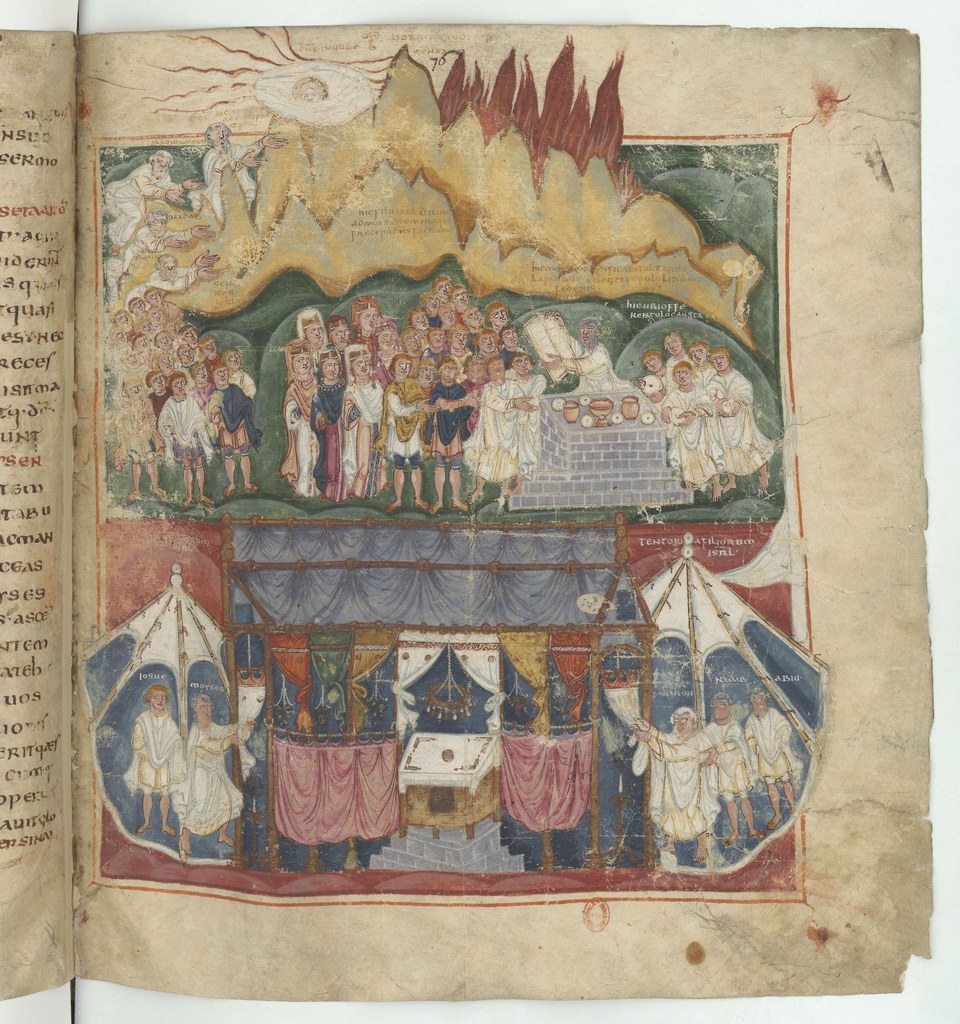
All these scenes show individual curtains being opened, not pairs. Paired curtains on their own could function like an aniconic honor guard, or like the two luminously pale angels screening a dark recess and inclining their heads like parted curtains to let in the light of God’s favor streaming from his hand above the Virgin’s throne on a well-known early icon at Sinai, while the pair of military saints on either side stand as solid and straight as pillars.This aspect of the icon is well illustrated in Terry and Maguire, Dynamic Splendor, 2: fig. 290, and in Fluck, Helmecke, and O’Connell, Egypt: Faith After the Pharaohs, 84–85, fig. 86. See also T. F. Mathews, “Early Icons of the Holy Monastery of St. Catherine at Sinai,” in Holy Image, Hallowed Ground: Icons from Sinai, ed. R. S. Nelson and K. M. Collins (Los Angeles, 2006), 39–56. In considering how curtains were hung, and how these ubiquitous objects controlled the perceived environment, we can picture their mediation of vision and light and their gestural opening and closing as they participated in comings, goings, and formal rituals. Behind or in front of a curtain a presence, divine or human, could be acknowledged, and, by the performative moving of a curtain, entrance could be permitted or denied. Persons and curtains and sources of light were mutually honored or spiritualized and even dematerialized in the imagination of those who designed and saw the real or fictive curtains. By imagining these curtains from their depictions, in relation to the examination of actual textiles, we may better understand people’s experience of the furnished world in early Byzantine centuries.
Gudrun Bühl, Elizabeth Dospěl Williams, Henry Maguire, Lain Wilson, Anders Berquist, and Shannon Wearing have all helped piece together these curtain observations to fit the publication portal. I am most grateful to them, and to Dumbarton Oaks for hosting the research project as a team effort.
Cite this Essay
Eunice Dauterman Maguire, “Curtains at the Threshold: How They Hung and How They Performed,” in Catalogue of the Textiles in the Dumbarton Oaks Byzantine Collection, ed. Gudrun Bühl and Elizabeth Dospěl Williams (Washington, DC, 2019), https://www.doaks.org/resources/textiles/essays/maguire.
